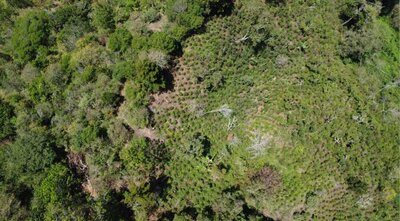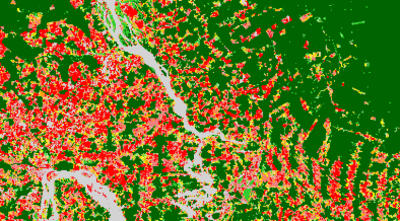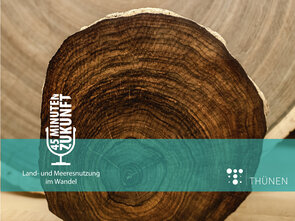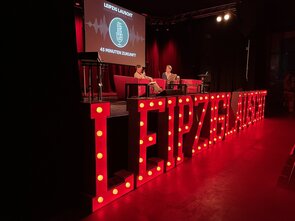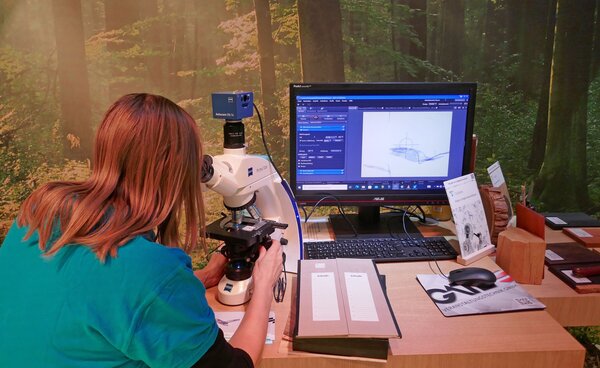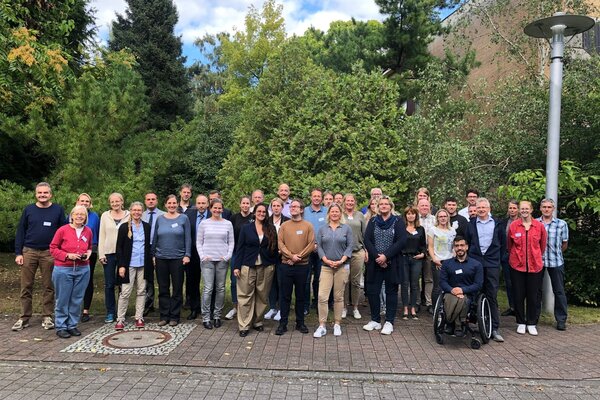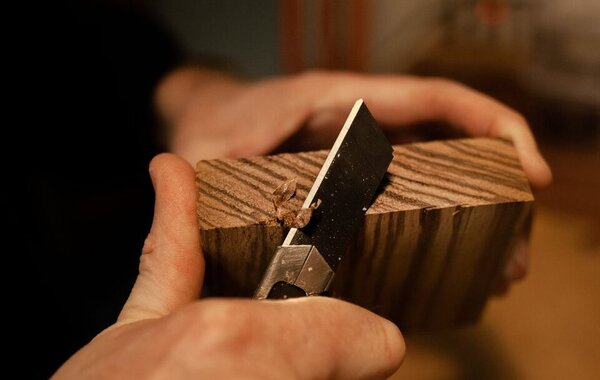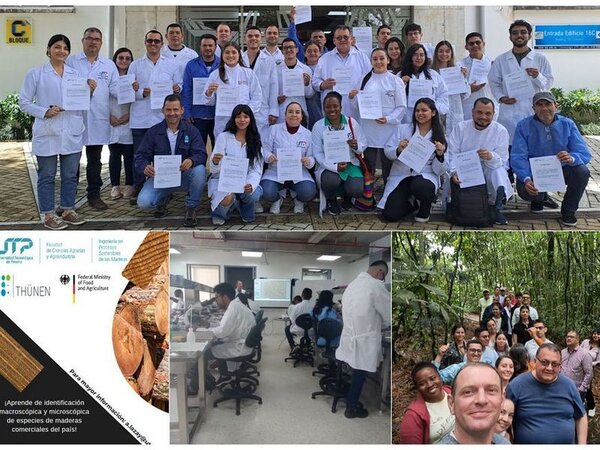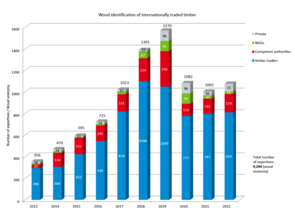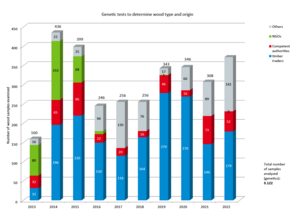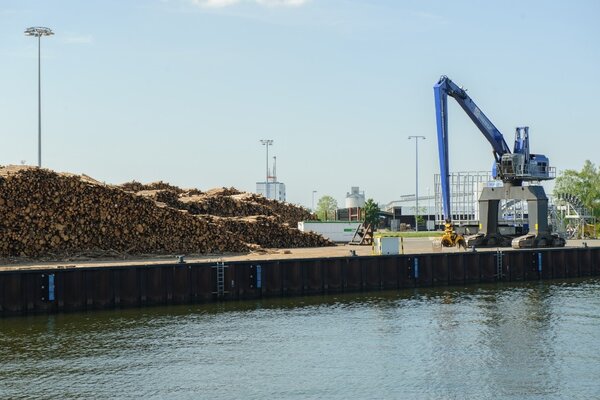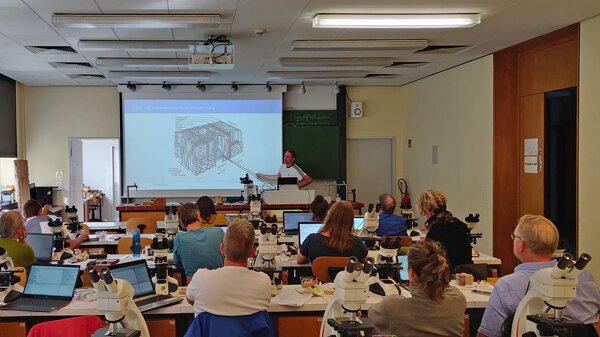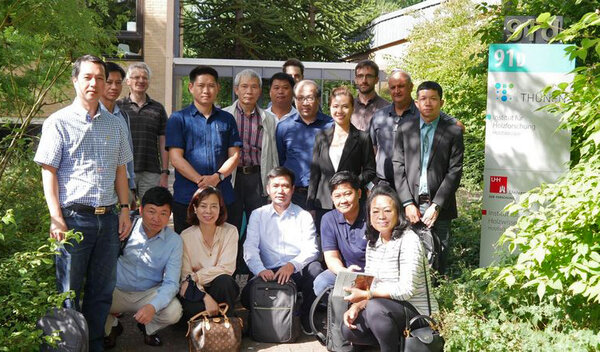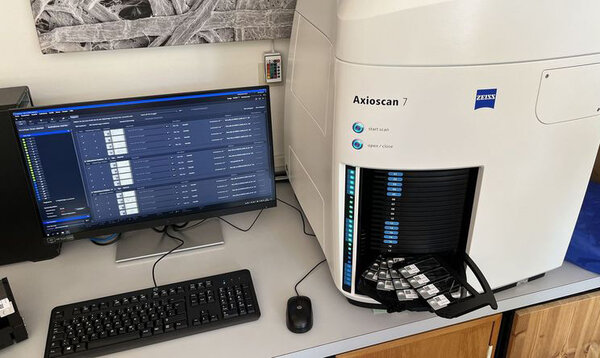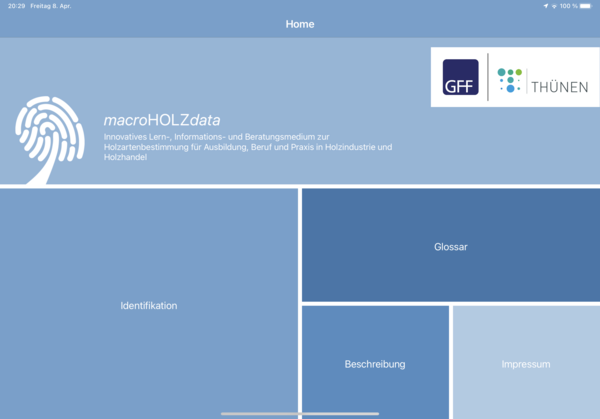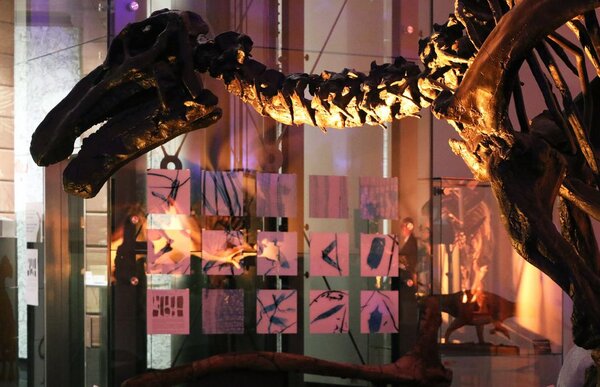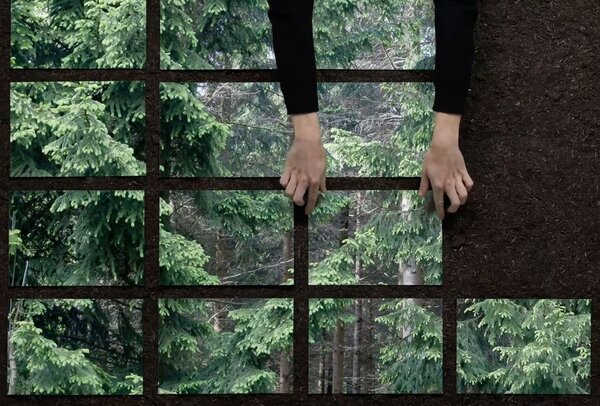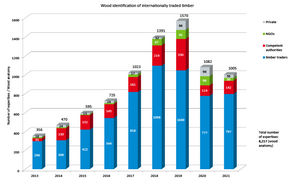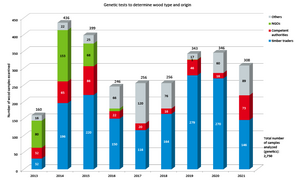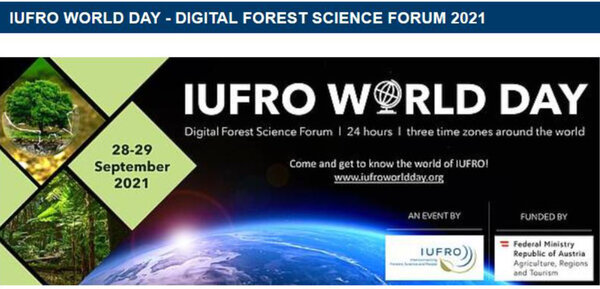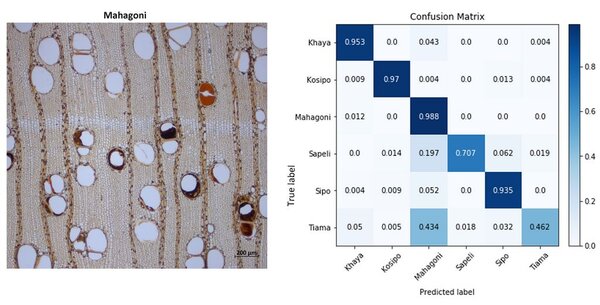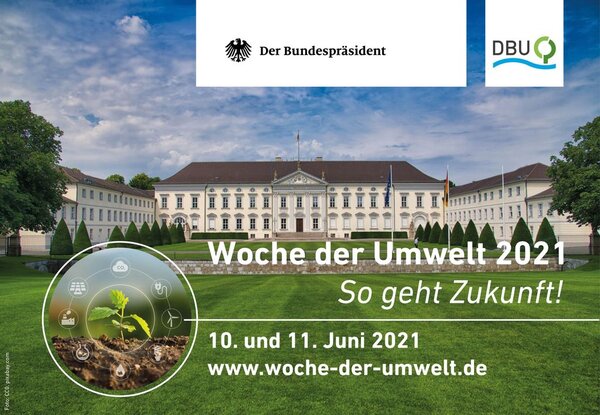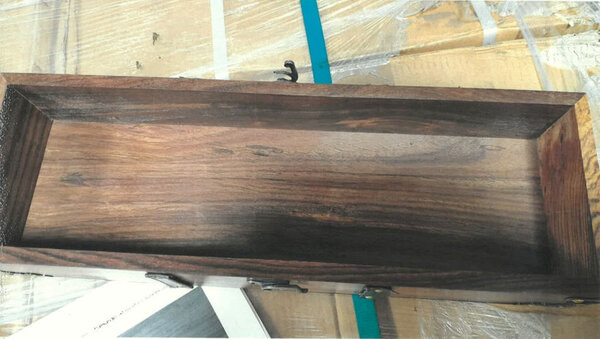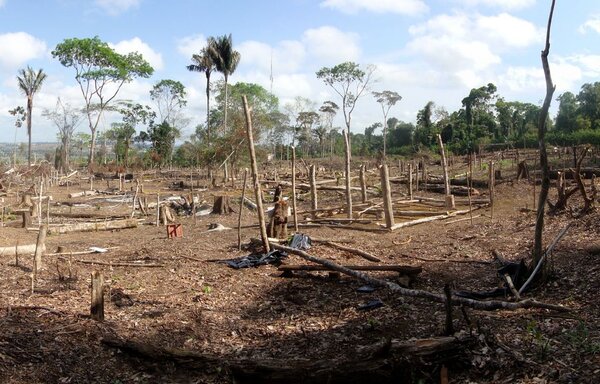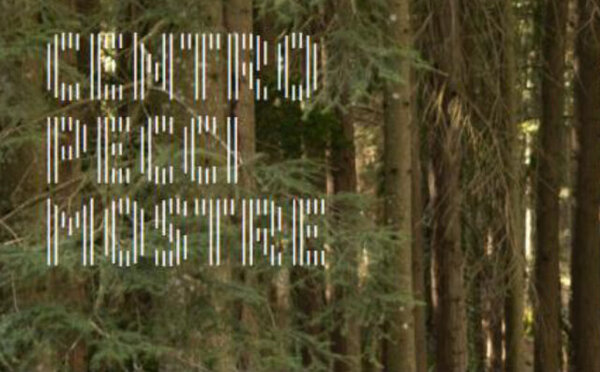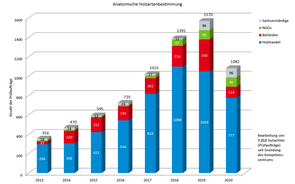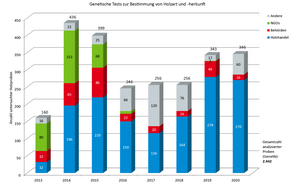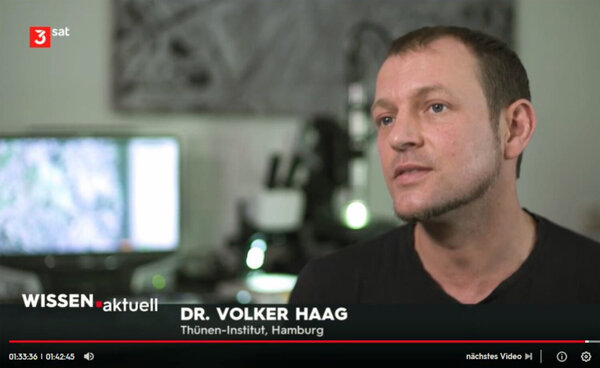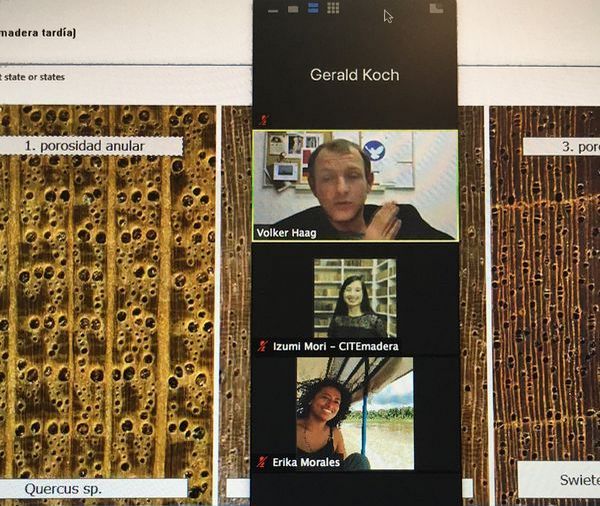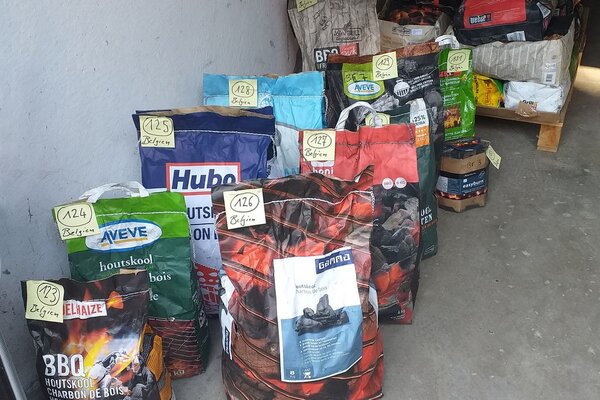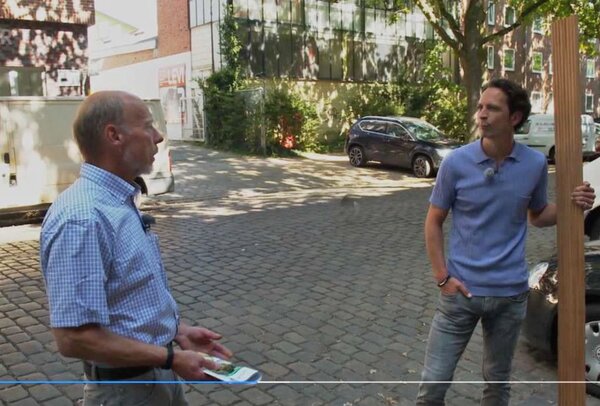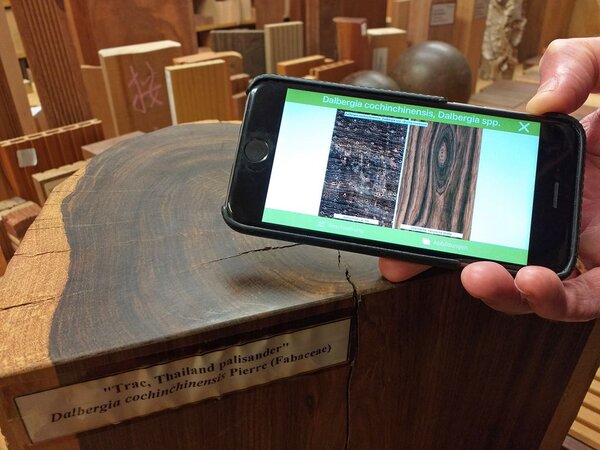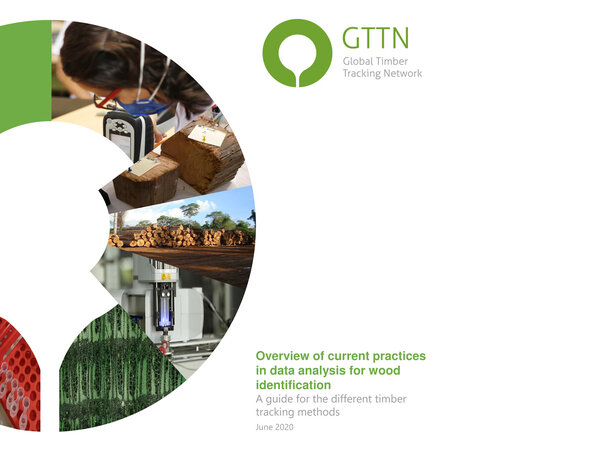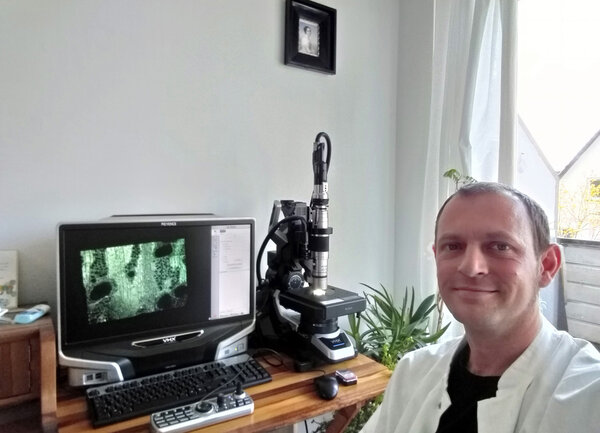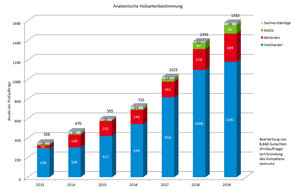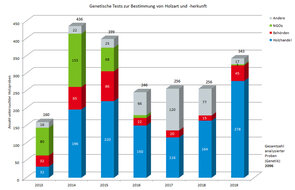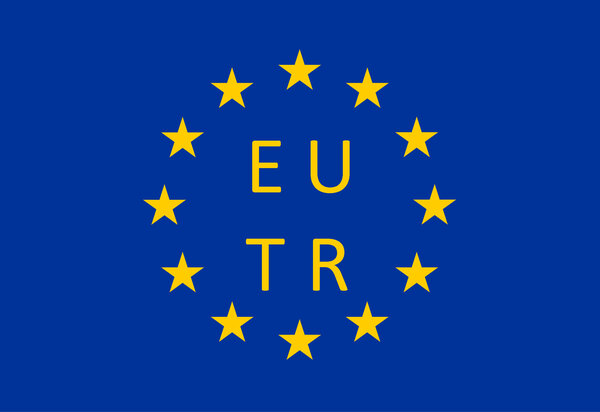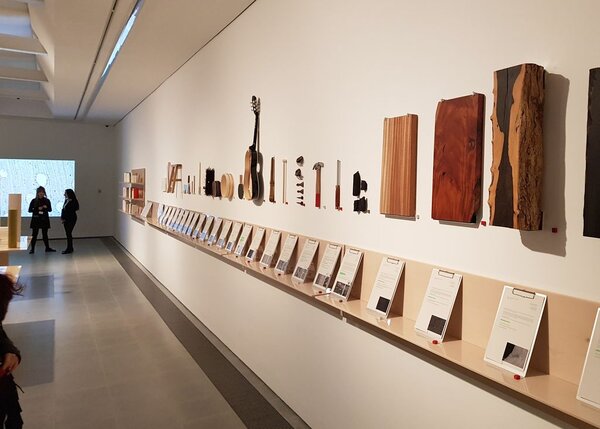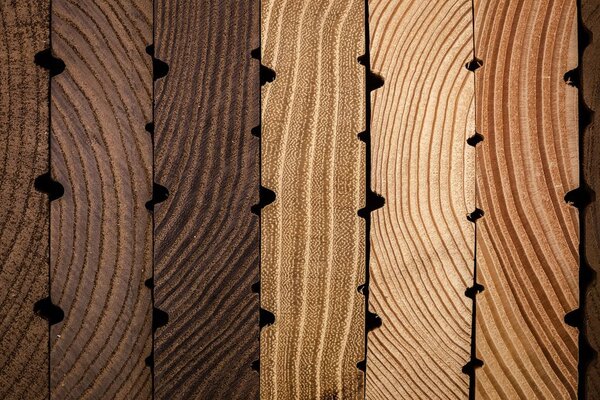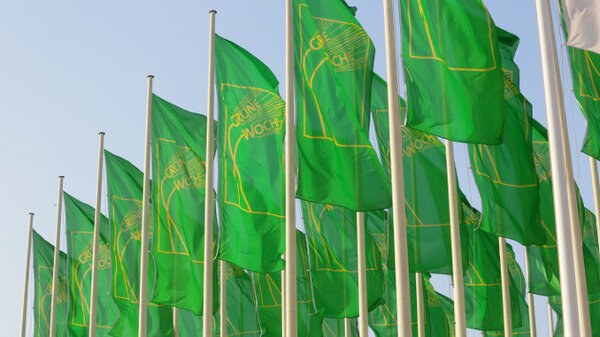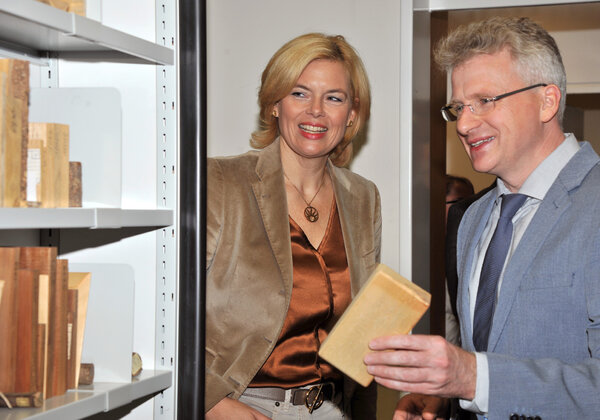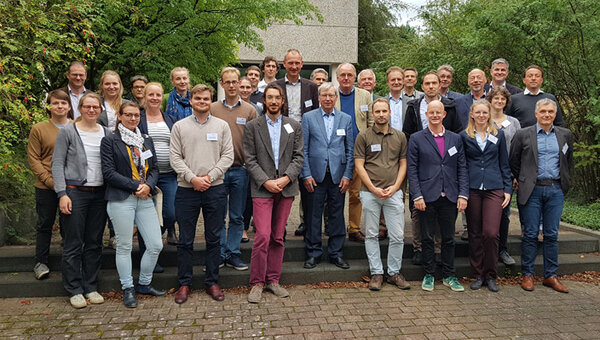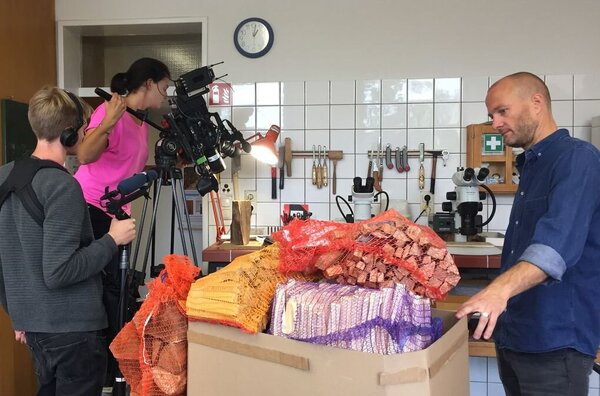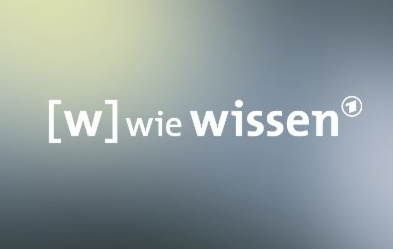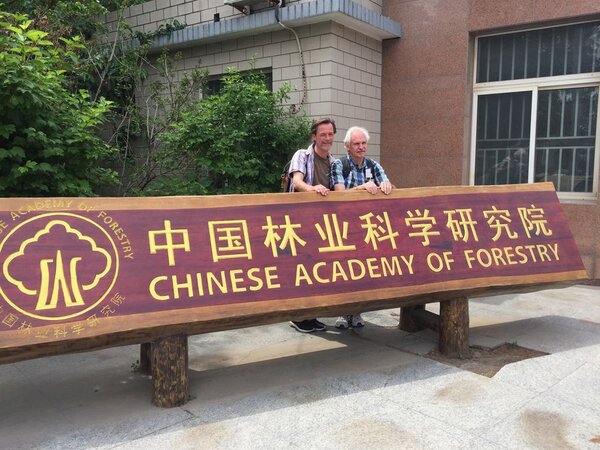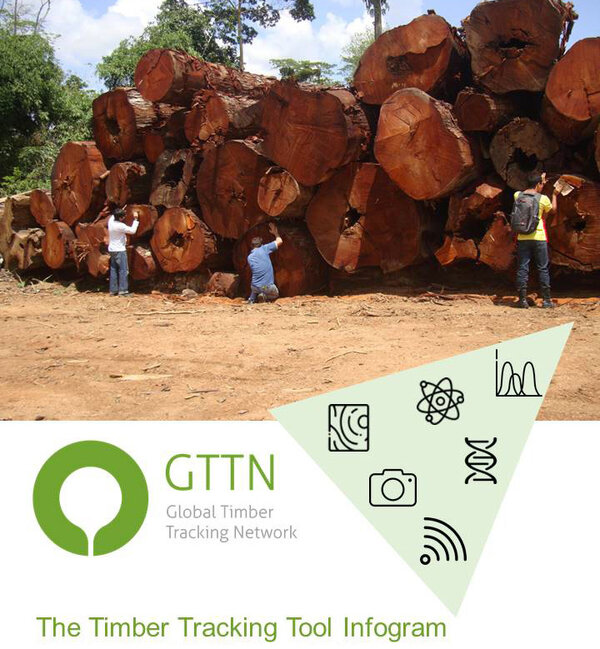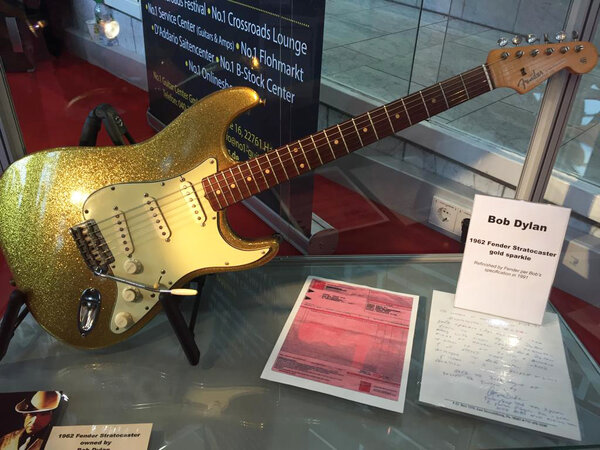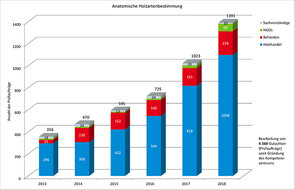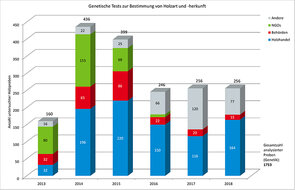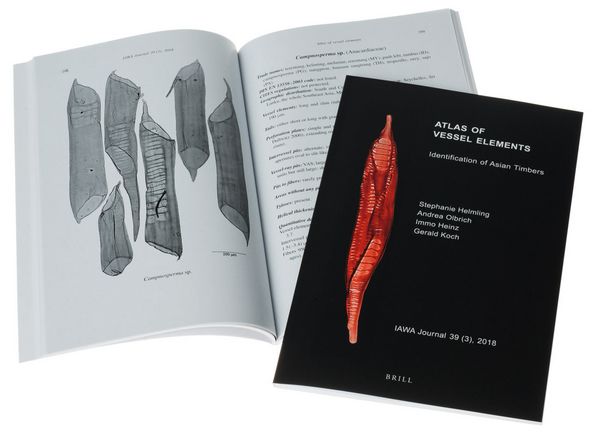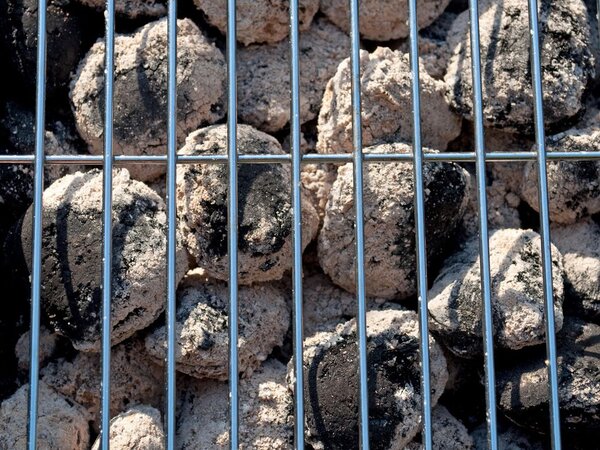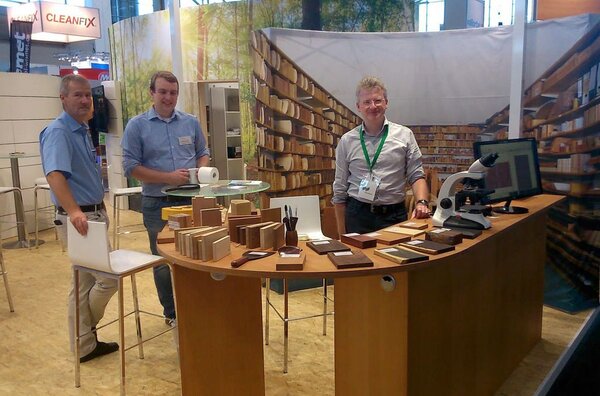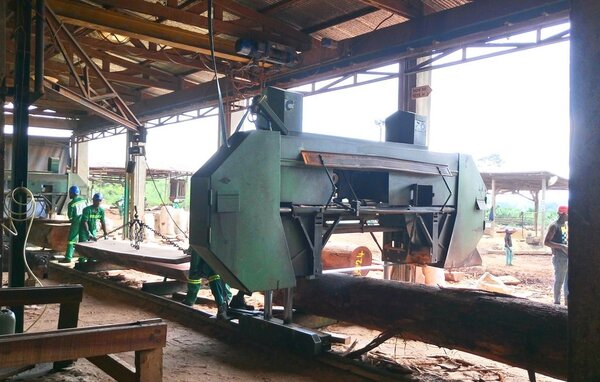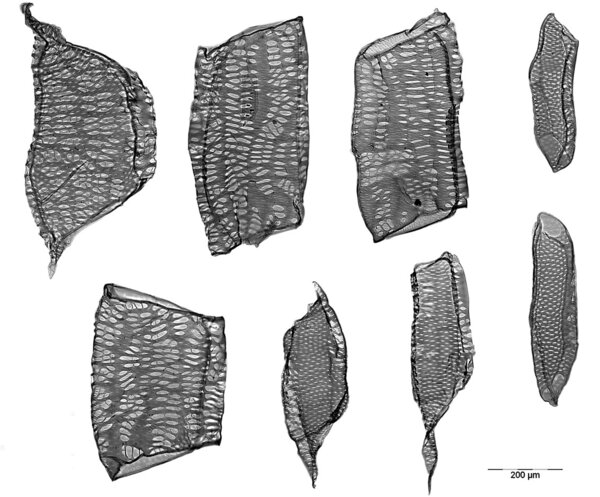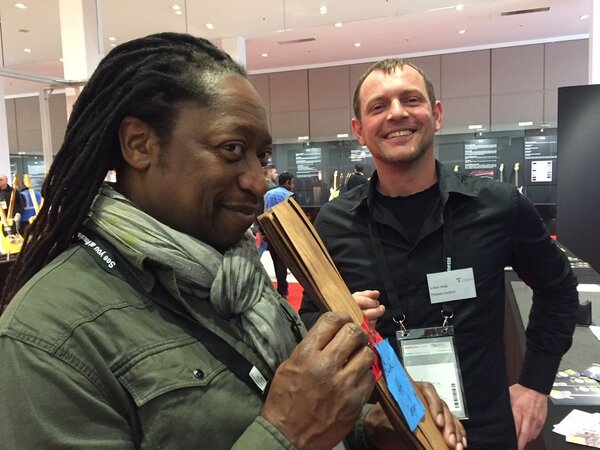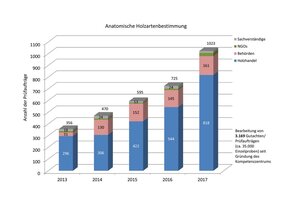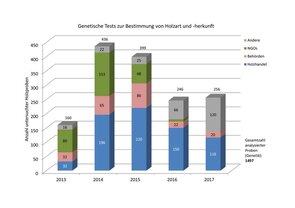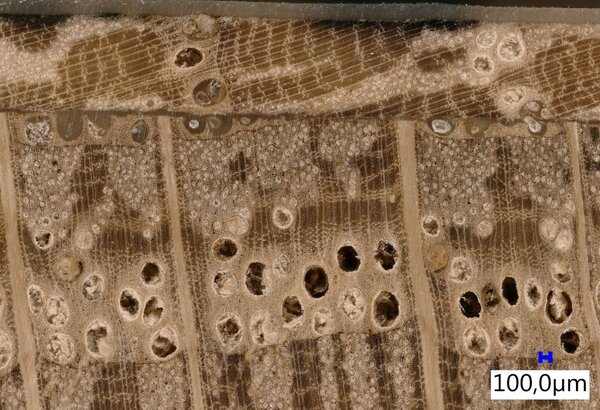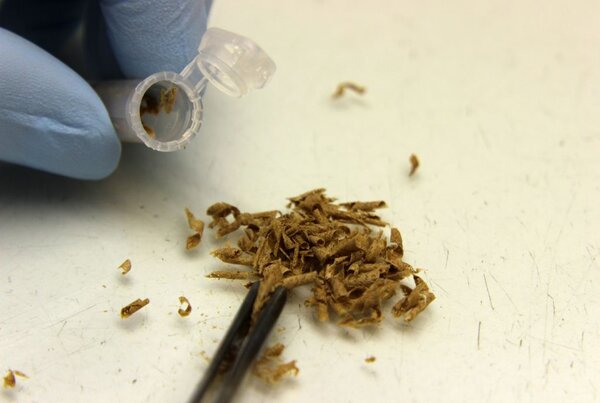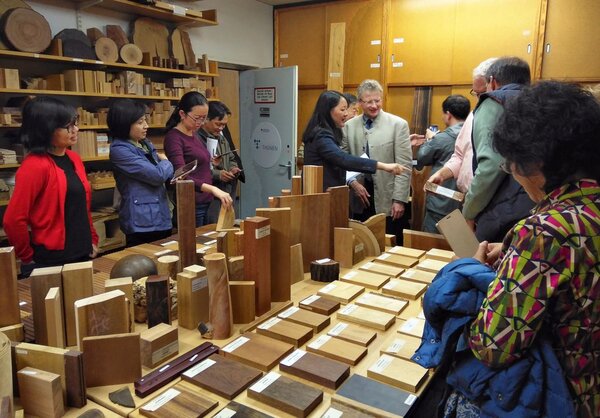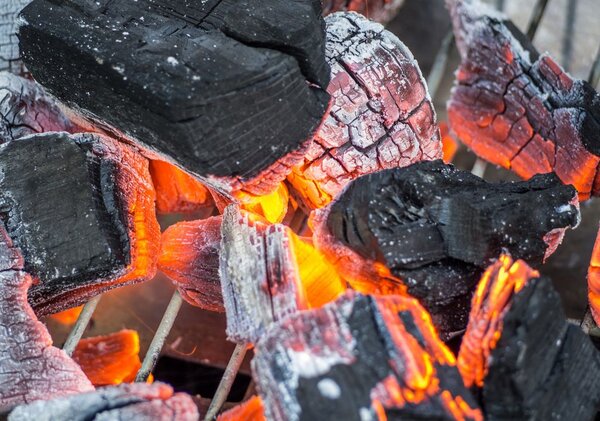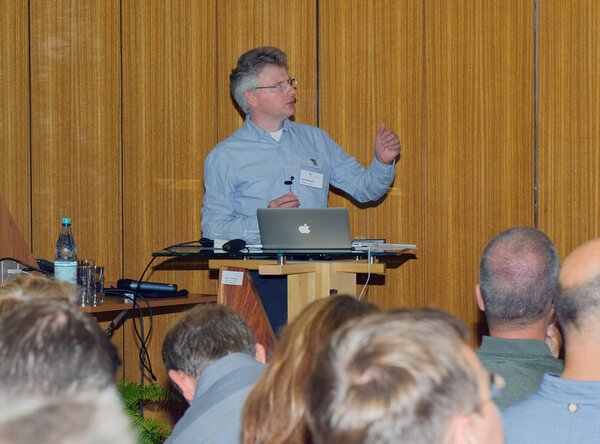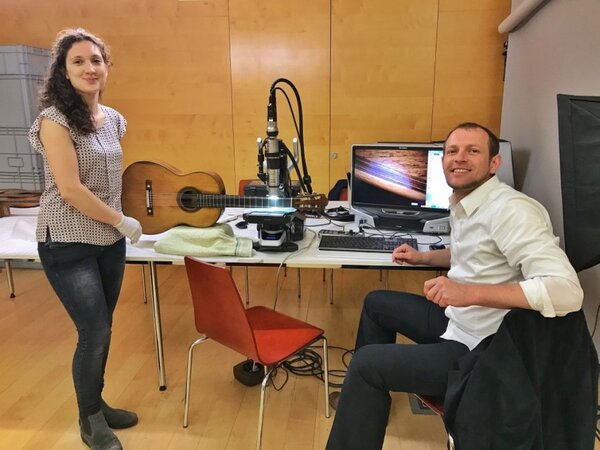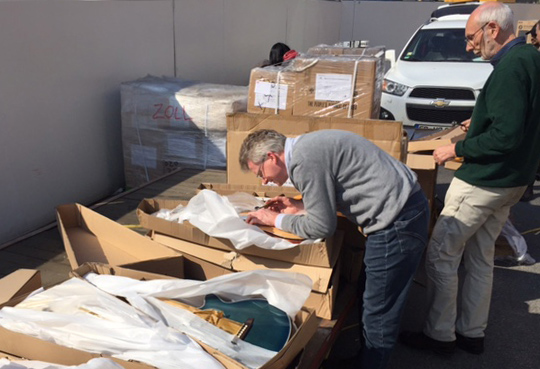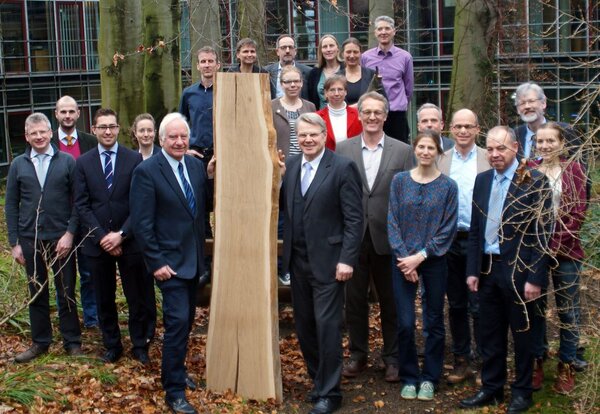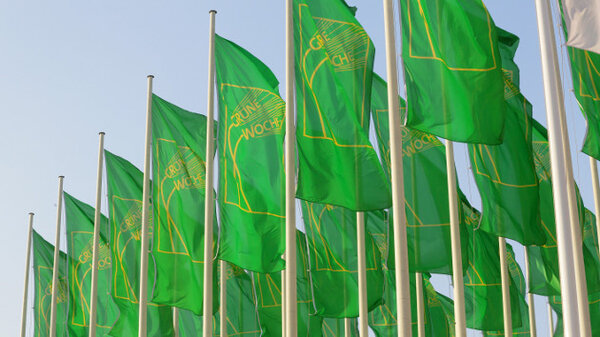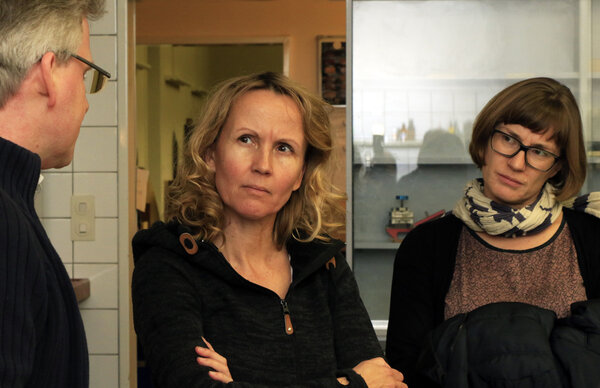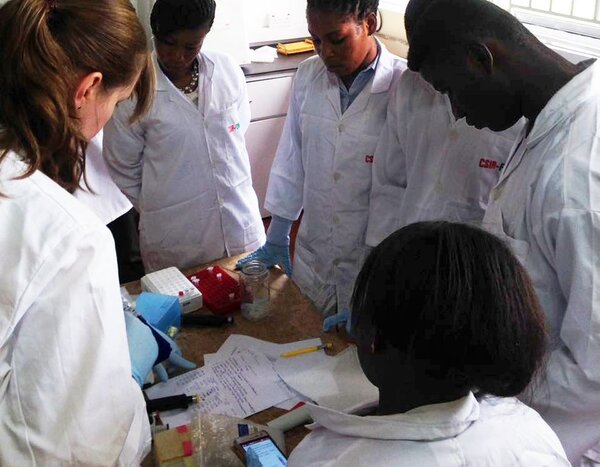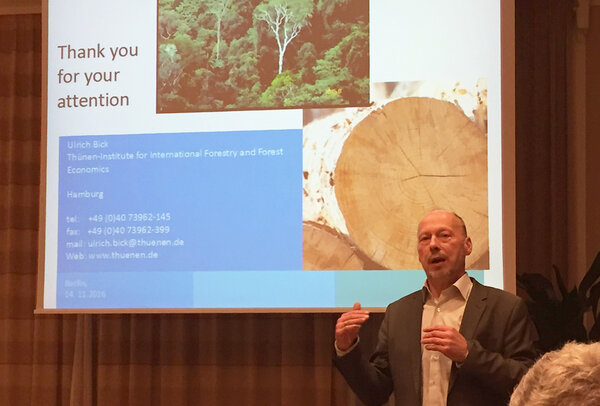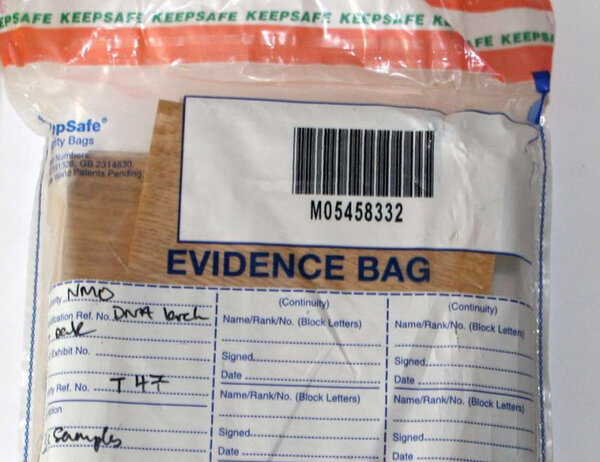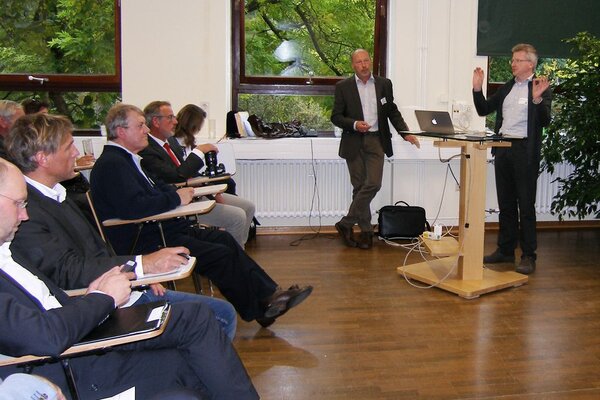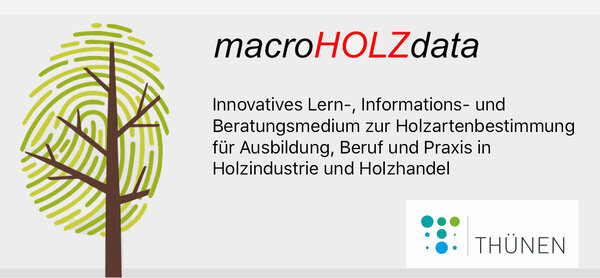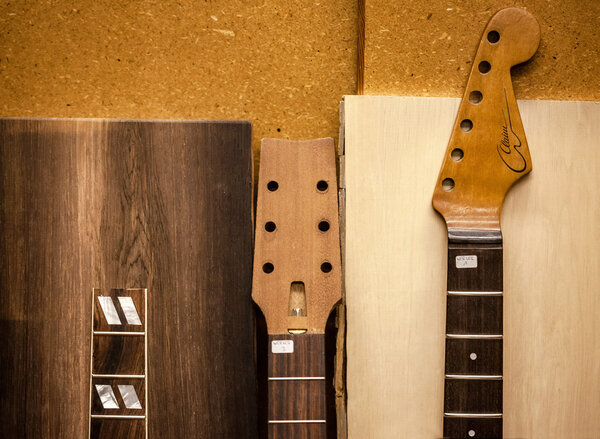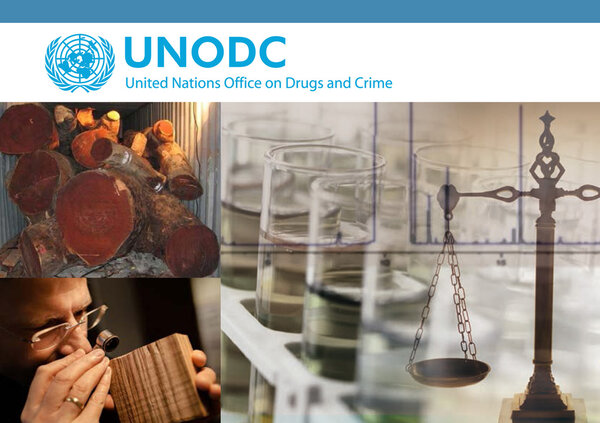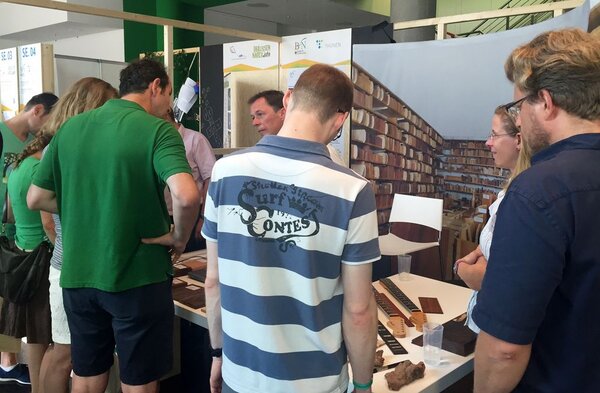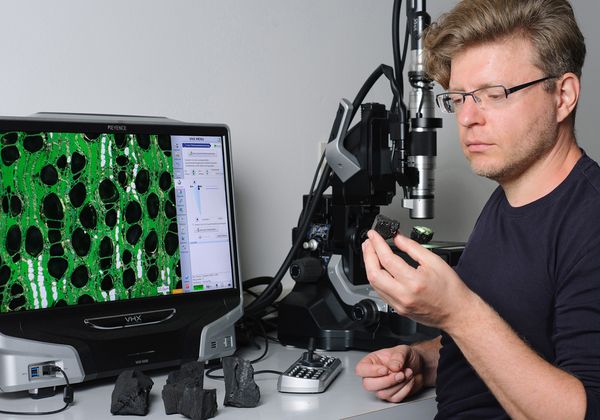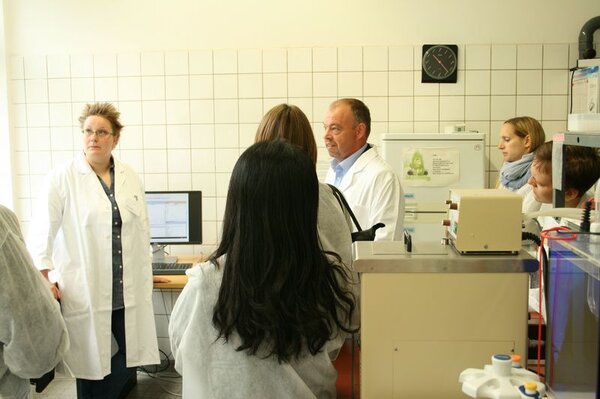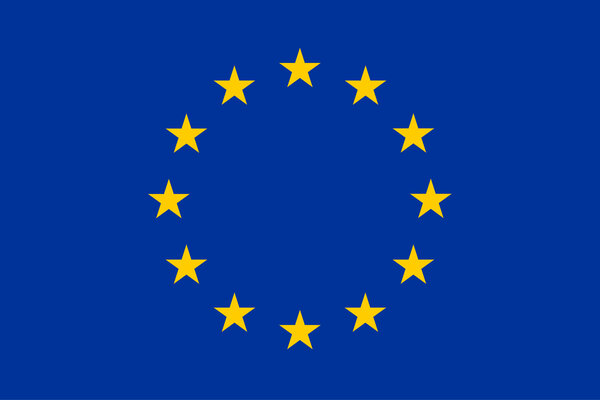Participation at conferences and conventions, new developments, exchanges with visitor groups, research trips: things are happening here! Current information about the work of the Centre of Competence can be found here.
Nov 24, 2025 Global Forest Maps Compared: Policy Brief and Study Available
As part of the GEOS-EUDR project, the Thünen Institute of Forestry assessed 21 global forest and tree cover datasets to evaluate their suitability for verifying compliance with the EU Deforestation Regulation (EUDR).
The findings are summarized in the newly released Technical and Policy Brief No.1, which is based on the peer-reviewed study Freitas Beyer et al. (2025) recently published in the Journal Remote Sensing.
The assessment found that only eight datasets meet key spatial, temporal and definitional criteria for EUDR compliance checks, and only two datasets fully match the EUDR forest definition (canopy cover ≥10%, height ≥5 m, minimum mapping unit ≥0.5 ha). The study also highlights significant regional inconsistencies, risks of over- and underestimation, and challenges in distinguishing natural forests from plantations and agroforestry systems.
The policy brief offers practical guidance for operators and supply chain actors preparing due diligence statements, Competent supervisory authorities, and policy and decision-makers shaping data and monitoring frameworks.
Key recommendations include:
- avoiding reliance on a single map,
- combining multiple remote sensing datasets,
- integrating national or regional reference information,
- and promoting harmonization of forest definitions to improve comparability.
Contact at Thünen Institute:
Apr 10, 2025 Neue Podcastfolge: There´s a lot of wood in it.
Wood from illegal logging remains a problem – even on the German timber market. Incorrectly declared wood ends up in building materials, furniture and paper. Genetic analyses can expose the wood products in question and find out where they actually come from.
Hilke Schröder develops genetic markers at the Thünen Institute of Forest Genetics to identify the type and origin of different woods. She is part of the team at the Thünen Competence Centre for Wood Origins, which analyses wood samples for traders, authorities and private individuals.
In this interview, the scientist explains how many wood products in Germany are affected and whether artificial intelligence could help to expose falsely declared products in the future. Hilke Schröder also reveals how she came to work for the police from time to time.
Jan 20, 2025 Foreign authorities increasingly draw on Thünen expertise
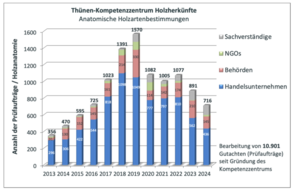
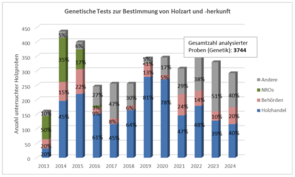
In 2024, the Thünen Wood Competence Centre received almost 8,000 testing orders, 716 of which were in the field of anatomical wood species identification and 60 (with 270 samples) in forest genetics. Since its foundation in 2013, the centre has carried out a total of almost 11,000 wood species determinations and origin analyses. The majority of clients are commercial enterprises, which primarily want to verify that the wood products they sell, such as fibreboard, paper products, plywood, chipboard and charcoal, contain what the manufacturers claim. These orders accounted for 60 per cent of the wood anatomy department in Hamburg-Bergedorf and 40 per cent of the forest genetics department in Großhansdorf. A good quarter of the orders now come from foreign trading companies, which also make use of the services offered by the competence centre. In 2024, the Wood Competence Centre even recorded a significant increase of seven per cent in testing orders for foreign authorities.
Testing orders for domestic authorities such as the Federal Office for Agriculture and Food (BLE) or customs account for a stable share of just under 20 per cent of the centre's order volume. Experts and private individuals also account for just under 20 per cent of orders. They commission the Wood Competence Centre to find out, for example, whether furniture, musical instruments and other items contain wood that is protected under the CITES species protection agreement.
In forest genetics, the botanical origin of oak wood was examined, particularly in solid wood samples such as furniture and components. Both species and origin are often misdeclared. The proportion is approximately 15 to 20 per cent.
Okt 24, 2024 Alternatives to natural forest teak put to the test in marine environments
It is not only sailors who are trained on board the German sailing training ship Gorch Fock. For several years now, alternatives to natural forest teak have also been tested in operation on the upper deck. On 24 October 2024, an interim assessment was made in Hamburg-Bergedorf.
Afzelia, iroko, itaúba and Tesumo® can take a lot: after three years of continuous use as deck planking on the German training ship Gorch Fock, the four different types of wood have met the expectations placed on them. "The back deck, on which the alternative woods are installed, is a working deck. The wood is subjected to heavy wear and tear," explains Gerald Koch, a scientist at the Thünen Institute of Wood Research in Hamburg-Bergedorf. After three years of use, the selected woods have fully met the expectations placed on them in terms of durability. The crew has also not noticed any differences in terms of slip and abrasion resistance.
During the workshop, the wood research scientists were joined by the commander of the Gorch Fock, Commander Elmar Bornkessel, and other representatives of the navy, the Federal Ministry of Defence, the Federal Ministry of Agriculture and the business community to report on the results of the monitoring and plan the next years of testing. In the coming years, the main focus will be on testing the long-term moisture behaviour of the wood under changing climatic conditions.
The test area on the upper deck of the Gorch Fock has been in place since July 2021. It was set up immediately after a timber trade embargo on teak from Myanmar came into force, but had been planned for some time. Afzelia, iroko, itaúba and Tesumo®, a modified tropical wood, were laid on 90 square metres instead of natural forest teak. In order to characterise the material and usage properties of the woods, measurements of moisture and colour behaviour are carried out and crack formation is documented. Alternatives to sanctioned natural forest teak from Myanmar are not only of interest for the restoration of old sailing ships, but also for manufacturers of modern yachts.
June 4, 2024: Die Holzforschung auf der Woche der Umwelt in Berlin
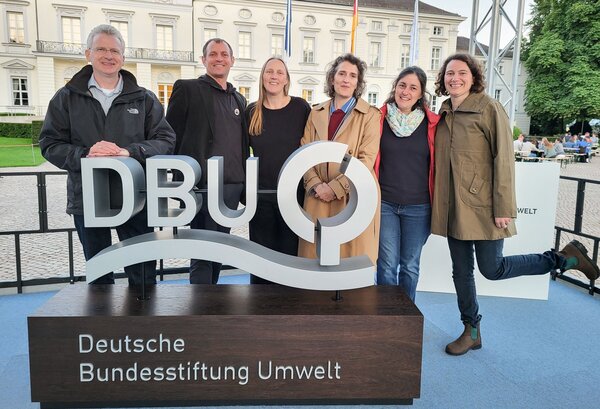
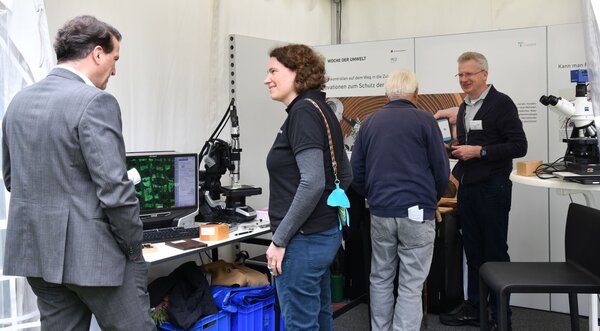
The Thünen Institute presented projects on increasing biodiversity in agriculture, humus formation in arable soils and digital wood species identification during this year's Environment Week in Berlin. Every four years, the Federal President and the German Federal Environmental Foundation (DBU) invite projects that have been previously selected by a jury to participate. In addition to joint projects led by the Thünen Institute on biodiversity in agricultural landscapes and humus formation in arable soils, wood anatomy was also represented.
At the exhibition stand in the park of Bellevue Palace, scientists demonstrated live on two microscopes how to identify the wood species of solid wood, charcoal and paper. Together with the Fraunhofer Institute for Industrial Mathematics (ITWM), they also presented their latest development: digital image recognition systems for automating wood species identification in paper using artificial intelligence. Paper samples were shown under the microscope at the stand and the AI systems were demonstrated on the computer.
The apps for macroscopic identification of solid woods met with great interest. These support customs and trade, but also interested laymen in the initial verification of the wood species. Among other things, this can clarify whether a species protected under the Washington Convention on International Trade in Endangered Species of Wild Fauna and Flora is present.
The identification of charcoal wood species shows the enormous influence that the research carried out at the Thünen Institute of Wood Science has on the international charcoal trade.
Contact:
Dr. Andrea Olbrich
Projects:
Wood Identification
Databases wood identification
Automated image recognition for wood species identification
The European Charcoal Transition
Jan 29, 2024: The milestone of 10,000 test orders has been surpassed
The Thünen Centre of Competence on the Origin of Timber has achieved a significant milestone. Since its establishment in March 2013, over 10,000 test orders for the anatomical identification of internationally traded timber and wood products have been processed. The majority of these, approximately 7,500 orders, come from trading companies. These companies submit test orders to proof and verify the declarations and wood species compositions in accordance with the guidelines of the European Timber Trade Regulation (EUTR/EUDR) and CITES convention. During the same period, approximately 1,800 reports were prepared for the relevant control authorities. Additional inquiries come from NGOs, experts, and also private individuals seeking the expertise of the Competence Center. The proportion of test orders from foreign companies and authorities is approximately 25%, emphasizing the international focus and perception of the Centre of Competence.
The comprehensive results of anatomical identifications of solid wood, wood-based materials, paper products, and charcoal provide valuable data for market observations and analyses to the scientists at the Centre of Competence. These results also contribute to the development of practical reference databases, such as the Apps macroHOLZdata/CITESwoodID and automated fiber recognition using artificial intelligence (machine learning).
Jan 19-28, 2024: Centre of Competence at the IGW trade fair
For the fifth time in the last twelve years the Thünen Centre of Competence is giving an overview of its activities at the International Green Week fair (IGW) in Berlin. This time, the focus is on detecting wood species in highly processed products such as paper and how artificial intelligence (AI) can support the wood detectives in their work.
In the hall 23a of the Federal Ministry of Food and Agriculture (BMEL), visitors can use a microscope to discover characteristic fibre elements from the paper material and assign them to specific types of wood. The CITESwoodID and macroHOLZdata apps are also presented on a large screen.
Nov 29, 2023: Study compares EUTR and EUDR
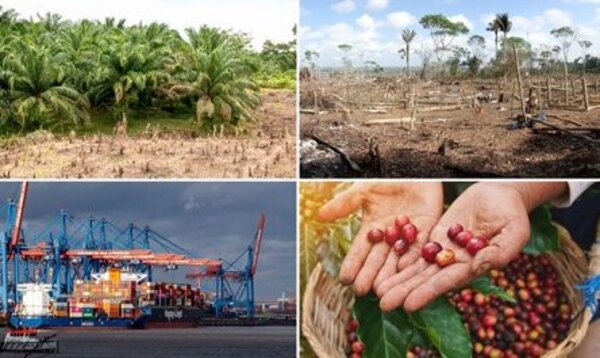
The EU Timber Regulation (EUTR), which came into force in 2013, will soon be replaced by the EU Regulation on deforestation-free supply chains (EUDR). A new study by the Thünen Institute of Forest Economics has compared the two regulations and analysed whether and how the weaknesses of the EUTR have been remedied by the successor regulation. The effects on companies in the timber sector and the control authorities in the EU were also analysed.
The scope of the new regulation is broader than that of the EUTR. The regulation prohibits the import of certain products - not just timber and timber products - into the EU if the raw materials used for them are associated with deforestation risks. Only products that are deforestation-free and legal under the legislation of the producing countries are compliant with the regulation.
It was found that the EUDR closes some important loopholes that existed in the EUTR. However, the new regulation creates significant additional burdens for companies and inspection authorities. More information can be found in an expertise article on the Thünen Website.
Original paper: Köthke M, Lippe M, Elsasser P (2023): Comparing the former EUTR and upcoming EUDR. Some implications for private sector and authorities. Forest Pol Econ 157:103079
Sep 14-15, 2023: International CITES Workshop
In cooperation with the Federal Agency for Nature Conservation (BfN), the Thünen Institute of Wood Research organised an international workshop on the identification of CITES-protected woods on 14-15 September 2023. More than 30 staff members from customs and CITES enforcement authorities as well as scientific institutions from five European countries took part in the workshop. The participants were able to learn about the identification of protected timber with the help of the CITESwoodID app and practiced its use.
The event also included a report on the extensive work of the Thünen Centre of Competence on the Origin of Timber and a presentation of new methodological developments in the field of anatomical wood species identification, such as machine learning and computer tomography. In addition, the workshop was an important forum for an international exchange of experience.
Mar 28, 2023: Radio report report on the wood detectives in Hamburg
The radio station Deutschlandfunk Kultur reported on the work of the Wood Detectives at the Thünen Centre of Competence on the Origin of Timber in Hamburg in an 8-minute feature in the programme "Zeitfragen" (Time Questions). It is about checking wood pellets for heating, charcoal and other wood products with unclear origins.
The background: Illegal timber trade is one of the largest areas of environmental crime worldwide. It promises a billion-dollar business and has glaring consequences for the climate, the environment and biodiversity.
Mar. 6-13, 2023: Cooperation with the Technical University of Pereira (Colombia)
In March, scientists of the Thünen Institute of Wood Research conducted a seminar on wood species determination at the Technical University of Pereira. The seminar took place within the framework of a recently extended Memorandum of Understanding between the university and the Thünen Institute.
The seminar covered the basics of wood anatomy and wood species science of Colombian commercial tree species, explained technical terms in the context of wood analytical studies, and provided training in the use of databases and programs for computer-assisted wood species determination. The 30 participants were mainly university teachers and students from the University of Pereira as well as representatives of the regional Colombian forestry authorities.
Feb. 13, 2023: Trading companies still very interested in testing
In 2022, as in previous years, it was mainly trading companies that approached the Centre of Competence with requests for testing of wood species or origin. The numer of requests for anatomical identification (1,077) was similar to that of the previous two years, while being higher for genetic analysis (372). Regarding the anatomical identification, the focus was on wood-based materials (fibreboard, particleboard, plywood, paper products); 16% of the testing orders were processed for authorities, 28% of the orders were performed for international trading companies. The focus on genetic testing orders remained on oak wood, wherein the question of origin became more important in 2022 than in the previous year. Larch wood played only a minor role in 2022 due to the war-related sanctions against Russia. The success rate for composite materials was significantly increased, mainly due to the "Wood DNA barcoding" project, in which genetic markers for various tree species in composite wood products were developed.
Jan. 31, 2023: Advancing to the origin of the raw material with a mathematical model
Scientists at the Thünen Institute of Forestry have developed a novel mathematical modeling approach based on trade data that indicates the location of origin of the wood contained in finished wood and paper products. The background: global trade in wood-based products has increased in recent years.
Certain environmental impacts, such as deforestation, are inherently linked to the location of origin of the roundwood. However, it is not always straightforward to determine the countries of origin. This is mainly due to the fact that in today's globalized world, wood and paper products are often imported as semi-finished or finished goods – from countries that had in turn previously imported the roundwood required for these goods. For example, wood products imported from China to Germany do not necessarily have to be made from wood that was also originally harvested in China. With the help of the model, considerable differences between the official trade statistics and the actual origin of wood could be uncovered. More information can be found in Project brief 2023/16a.
Sep. 12-16, 2022: Wood determination seminar for criminal biologists in Hamburg
From 12 to 16 September, the Thünen Institute of Wood Research held a seminar for criminal biologists with a focus on wood species determination. 12 persons from Germany and Austria participated. In the seminar, the police officers were taught practices for macroscopic and microscopic wood species determination, which can give them more confidence in determining wood species. They learned the basics of wood anatomy and wood species knowledge and were enabled to carry out own practical examinations of solid wood and microscopic cut preparations. In addition, they were trained in the use of databases and programmes for computer-assisted wood species identification. Courses on special fields of application such as paper and fibre analysis, 3D microscopy and the development of automated image recognition systems for wood species identification with the help of artificial intelligence rounded off the programme.
July 18, 2022: Delegation from Laos and Vietnam visits Thünen Centre of Cempetence
A group of experts from Laos and Vietnam informed themselves at the Thünen Institute about the work and research in the field of anatomical wood identification. The visit was part of a technical excursion of representatives from industry and regulatory authorities on the topic of "Implementation of timber trade regulations of the United Kingdom and the European Union". It took place within the framework of the Forests4Future (F4F) project of the German Society for International Cooperation (GIZ). GIZ supports international projects for legal timber trade in accordance with the European Union's FLEGT Action Plan. The Thünen Centre of Competence provides an important contribution to these efforts by checking the declarations of internationally traded timber and timber products.
June 29, 2022: Automated microscopy in the fibre laboratory
For the implementation of artificial intelligence (AI) in wood species identification of fibre baed materials (project KI-Wood_ID), it is important to generate as much training data as possible within the machine learning process. Specifically, these are microscopic images of whole slides with stained fibrous tissues of individual wood species are analyzed. With their help, the AI is trained to recognise the cells they contain. A new light microscope has recently been installed in the fibre laboratory, which can be equipped with 100 slides simultaneously. These are then automatically scanned over the entire surface in several focal planes. In 24/7 operation, the image data volumes, which are required for the project, can thus be collected extremely efficiently and forwarded to the project partners of the Fraunhofer Institute ITWM.
June 7, 2022: Wood anatomy at Milan Fashion Week
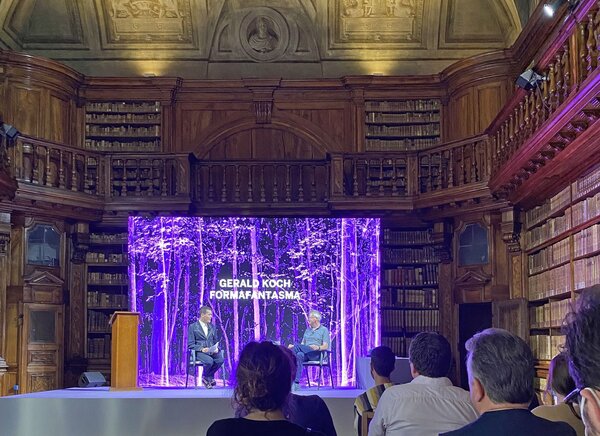
In the context of the Milan Fashion-Week 2022 the designer studio Formafantasma curated an international symposium "PRADA Frames – On Forest" (June 6 to 8) to inform and discuss with designers, architects, artists, and scientists about the functionality and aesthetics of forest ecosystems as well as the use of the natural material wood.
The requirements of a legal and sustainable wood utilization were presented by Gerald Koch (Thünen Institute of Wood Research) interviewed by Simone Farresin (Formafantasma). Furthermore, the importance of anatomical wood identification for the control of internationally traded timber and wood products was demonstrated. The symposium was staged in the special atmosphere of the National Library (Biblioteca Nazionale Braidense). The program and contents are fully available at the following links:
https://www.prada.com/de/de/pradasphere/special-projects/2022/prada-frames.html
https://www.youtube.com/watch?v=FyhUU28EZJ8
May 13, 2022: New app "macroHOLZdata"
The knowledge about recognition and utilization of the most important internationally traded timbers is of prime importance to forestry and wood industry as well as timber trade and even control authorities. As an important tool for this purpose, the database macroHOLZdata developed at the Thünen Institute for Wood Research has been programmed as an app for smartphones and tablets and is now available. The macroHOLZdata app offers:
- interactive identification of 150 common trade timbers (hardwoods and softwoods) based on macroscopic features to be observed with the unaided eye or with a hand lens,
- high-quality illustrations of wood characters and timbers featuring transverse and longitudinal surfaces
- a database offering pertinent information on wood properties, processing, and utilization.
The app is also ideal suited for further education and training in forestry and timber industry as well as self-study. The app can be downloaded free of charge from the App Store and Google Play using the search term macroHolzdata.
May 1, 2022: Senckenberg Night
The 12th "Senckenberg Night", at which personalities were honored for nature research and special commitment to nature conservation in a festive setting, was this year entirely focussed on the "World of Forests". For the festive event at the Senckenberg Museum in Frankfurt, the Thünen Institute of Wood Research donated microscopic images of wood cells and provided information on wood species identification for forest protection. The images were effectively presented under dinosaur skeletons. During the charity gala the images were sold for the benefit of the „Senckenberg Förderverein“.
Jan. 26, 2022: Cambio Exibition in Zurich
The Museum für Gestaltung in Zurich (Switzerland) is showing the exhibition "Cambio" by the Italian designer duo Formafantasma until May 8. The exibition deals with the material wood and the question of what role this material can and should play in design in view of the climate crisis. The Thünen Centre of Competence has contributed several exhibits and determined the types of wood from various wood products and papers shown in the exhibition.
The German newspaper Süddeutsche Zeitung acknowledged the exhibition in an article on Jan. 25. "Cambio" has already been shown in Prato/Italy (2021) and in London (2020).
Jan. 10, 2022: Ongoing high number of testing orders
Requests for wood testing (anatomical and genetic) were further high in 2021 – roughly on the same level as the year before. Regarding the wood anatomical investigations, the focus shifted to the more work-intensive identification of wood-based materials (fibreboard and chipboard, plywood, paper products) and charcoal. About one third of the enquiries came from foreign companies. In the genetic field, the requests and analyses were focused on oak specimens, especially with regard to proof the wood origin. Larch specimens represented nearly a quarter of the test orders in 2021. Enquiries from authorities, especially the BLE, increased significantly. In addition to solid wood, processed products were increasingly examined.
Sep. 28-29, 2021: IUFRO World Day
Scientists from the Thünen Centre of Competence participated in the World Day 2021 of the International Union of Forest Research Organizations (IUFRO), which was held online due to Corona. In the section "Wood identification", Volker Haag presented anatomical methods for wood identification in materials such as fibreboard, pulp, paper and charcoal. Gerald Koch informed about new methodological achievements, e.g. the use of digital methods for wood identification and the potential of artificial intelligence. The contributions can be seen in the YouTube video from 5:45 min (V. Haag) and 13:38 min (G. Koch).
Sep. 24, 2021: Artificial intelligence (AI) with potential
In cooperation with the Hamburg University of Applied Sciences (HAW), the Wood Anatomy Unit of the Thünen Centre of Competence has for the first time developed and tested an automated image recognition system for the microscopic identification of important economic tree species from the MELIACEAE family. For the development and training of a computer-assisted neural network (machine learning), a total of 6,964 microscopic transverse-sectional images of the wood species true mahogany, khaya, kosipo, sapele, sipo and tiama were recorded and digitised. The results of the automated wood species identification show a very good success rate with accuracies of over 95% for true mahogany, khaya and kosipo (see graph).
It can be assumed that digital/automated systems based on artificial intelligence (AI) can be successfully established for anatomical wood species identification in the foreseeable future.
More information (in German): Holz-Zentralblatt 38, Sept 24, 2021
June 10-11, 2021: Week of the Environment
At this year's Week of the Environment, hosted by the German Federal President and the Deutsche Bundesstiftung Umwelt (DBU), the Thünen Centre of Competence, together with the University of Hamburg, is presenting innovative methods for identifying which woods are used in the production of paper. The background: paper production is a global business, and often the wood used as raw material comes from illegal logging. Aim of the project is to draw conclusions about the wood species used for paper products, by means of light microscopic or chemotaxonomic examinations.
Also the barbecue charcoal sold in Europe is often falsely declared. Within a DBU funded project, carried out at the Thünen Institute, references for the identification of tropical and sub-tropical woods in charcoal are to be established. The current progress of the work is presented.
More information: https://www.woche-der-umwelt.de/ausstellerKonkret/1634
June 2, 2021: Hamburg customs took action
During a routine inspection at the end of March 2021, customs officers from Hamburg's main customs office came across disassembled wooden chests with unclear information about the wood species. Based on the customs declaration, there was a suspicion that the wood could be a protected rosewood species. The suspicion was confirmed in cooperation with the Thünen Centre of Competence on the Origin of Timber. It was Indian rosewood (Dalbergia sissoo), a wood species that is covered by the import regulations of the Convention on International Trade in Endangered Species of Wild Fauna and Flora (CITES). As the necessary import permits could not be presented by the importer, the wooden chests were confiscated by the customs authority.
May 31, 2021: Causes of illegal logging
Which factors promote illegal logging? Matthias Bösch from the Thünen Institute of International Forestry and Forest Economics has analyzed this in a recently published study. In addition to confirming numerous widespread assumptions, it is shown that above all economic development and the institutional constitution of a country (e.g. the extent of the rule of law, the degree of government accountability, the presence of corruption) are of great importance for the existence of illegal logging. Armed conflict and population pressure, on the other hand, are seemingly less important.
The results of the study are also of interest for possible improvements of existing policies to combat illegal logging. For example, the identified factors could be used to better assess the risk of a country of origin in the due diligence practice of operators under the EUTR.
May 15, 2021: Cambio exhibition in Prato, Italy
From May 15 to October 24, 2021, the exhibition "Cambio" by the Italian designer duo Formafantasma is on display at Centro Pecci (Prato, Italy). It is about the interaction between the traditional disciplines of design, contemporary art and research.
The Thünen Institute of Wood Research is supporting the exhibition with various exhibits, including samples of protected woods and everyday wooden objects. Last year, "Cambio" was already shown at the renowned Serpentine Sackler Gallery in London (see below).
Apr. 20, 2021: Testing orders show corona dip
After six years of uninterrupted growth in demand for anatomical wood species testing, the number of testing orders at the Thünen Centre of Competence has declined for the first time in 2020. This is possibly due to the long lockdowns and the reduced economic activity during the Corona pandemic. The focus of the investigations has shifted further to wood-based materials such as fibreboard, plywood, paper products as well as charcoal. Test requests from other EU countries also increased. In the case of genetic tests, the number of testing orders in 2020 was about the same as in the previous year. By far the largest number of requests came from companies dealing with wood and wood products.
Jan. 22, 2021: 3sat - Save the forests!
On 21 January 2021, the German TV channel 3sat broadcasted in its series "Wissen aktuell" the one-and-three-quarter-hour programme "Rettet die Wälder!"(Save the Forests!) about the many threats to forests, not only in Germany but also globally. One aspect: charcoal, sold in Germany, but often originating from countries like Nigeria, Paraguay or even from Eastern European natural forests. Experts at the Thünen Centre of Competence use a special 3D reflected-light microscopy procedure to check which wood species were used to produce charcoal. In this way they can often draw conclusions about its origin. Thünen researcher Volker Haag explains the procedure.
Nov. 19, 2020: Online workshop in Peru
Due to Corona, numerous workshops and conferences have to be held online worldwide. Against this background, a GIZ (Gesellschaft für Internationale Zusammenarbeit) funded workshop focusing on wood species identification, which was planned for Lima (Peru), was conducted online.
To the great delight of the organising scientists at the Thünen Institute, this form of expert lectures was able to reach a much larger circle of interested parties than initially planned. The information on the workshop was passed on by the Peruvian research institute CITEmadera to research institutions in South America via numerous media channels (websites, Facebook etc.). The webinar "Opportunities and limits of anatomical wood ID, stable isotopes and genetic methods as tool for the regulation of the international timber trade" (authors: V. Haag, K. Paredes, G. Koch) was held on 19.11.2020 and was attended by more than 200 people from five countries (Peru, Brazil, Bolivia, Mexico, Germany).
In addition to the lectures, videos were presented that could be financed with the funds that were actually planned for the organisation of the face-to-face workshop. The positive response to the online workshop was still evident days after the date, with many positive feedbacks by e-mail.
Nov. 16, 2020: Charcoal studied throughout Europe
Which woods are used to produce the charcoal we usually use for barbecues? This has been analysed by the Thünen Institute and the WWF in a joint Europe-wide project. Between October 2019 and April 2020 a total of 150 bags of charcoal and charcoal briquettes were purchased in eleven European countries (Germany, Poland, Switzerland, Spain, Italy, Norway, Denmark, the Netherlands, Ukraine, Czech Republic and Belgium). At least 30 samples from each package were examined at the Thünen Institute of Wood Research with a 3D reflected-light microscope (Video) to determine the composition of the wood species contained therein.
The results have now been compiled in a WWF brochure (in German), which can be downloaded at ReseachGate. The corresponding scientific paper was published in the IAWA Journal in 2020.
Nov. 9, 2020: DIY stores tested
The German television channel NDR tested in its magazine MARKT (broadcasted on November 9, 2020) how good the advice was when buying FSC-certified decking boards in the DIY stores OBI, Bauhaus and Hornbach. Within the testing team: Ulrich Bick, forestry scientist and certification expert from the Thünen Institute of International Forestry and Forest Economics. The conclusion: both the presentation of the goods and the advice provided by the sales staff varied greatly and was not always at its best.
Oct. 28, 2020: New CITES app
The ability to identify CITES-protected wood species is of prime importance in the implementation and enforcement of the CITES controls. A valuable support for computer-aided wood identification is provided by the new CITESwoodID app. Using this app, the most important CITES-protected timber can be identified on the smartphone or tablet by means of macroscopic structural features. The database CITESwoodID was developed by the Thünen Institute, the app was published by the Federal Agency for Nature Conservation (BfN).
The app contains descriptions and an interactive identification system of 46 CITES-protected timber (e.g. ebony, mahogany, rosewood) and 34 similar traded timbers, which can be mistaken for CITES taxa. It has been programmed for Android®, iOS® and UWP® operating systems and is available for free download in German, English, French and Spanish in the respective app stores since October 26.
App Store:https://apps.apple.com/us/app/citeswoodid/id1534768227
Google Play:https://play.google.com/store/apps/details?id=de.bfn.CITESwoodID
June 19, 2020: New guide for timber tracking methods
Which scientific methods of the determination of wood species and origin are aavailable? Where are their strengths and limitations? A comprehensive overview is provided by the Global Timber Tracking Network's (GTTN) English-language guide, which has now been published at the end of the second project phase. It describes five methods (wood anatomy, genetics, stable isotopes, mass spectroscopy and NIR spectroscopy) that are used worldwide for the testing of wood and wood products. It also provides advice on the creation of reference data (databases). Thus it makes an important contribution to the harmonization of analytical methods within the global network of experts and institutions working on the containment of illegal logging.
39 scientists from 30 international institutions have contributed to the guide, including eight from the Thünen Centre of Competence on the Origin Centre Wood Origins. Financial support was provided by the BMEL in the context of the coordination of the GTTN project.
Apr. 13, 2020: Unusual workplace
As the staff of the Thünen Institute has officially been mandated to work in home office due to the Corona pandemic, Volker Haag from the Institute of Wood Research has taken the 3D reflected light microscope and the connected histology home with him. In his living room he is now examining 140 charcoal assortments from 11 European countries as part of the project "The European Charcoal Transition". The question is, which wood was used as resource for the charcoal. The work continues the investigations of the past years.
Mar. 26, 2020: Increasing demand for wood testings
In 2019, the demands for testing the species and origin of wood at the Thünen Centre of Competence have increased significantly again. In the wood anatomy unit, 1,582 test orders were processed, around 14% more than in the previous year. In the genetic laboratory there were 343 tests, an increase of around 35 %. As in previous years, the main clients were trading companies with wood and wood products, including DIY stores, discounters, etc. There was also an increase in test orders for control authorities. Since the start of the Centre of Competence in 2013, a total of more than 8,200 orders have been processed.
Mar. 23, 2020: How is the EUTR implemented?
A survey by the Thünen Centre of Competence for the implementation of the European Timber Regulation (EUTR) among German importers has shown that the knowledge about the EUTR is low, especially among small companies outside the timber industry. However, these companies make up the majority of importing market participants.
Only 42 % of the 540 market participants interviewed knew about the EUTR and were aware that the regulation applies to them as well. However, together they account for 91 % of the total value of imported EUTR products of all respondents. 28 % of operators, which cover 76% of the import value, had installed a due diligence system. This reflects the high level of knowledge and implementation of major market players. The low level of implementation by small companies from outside the sector is mainly due to lacking information and indicates unequal access to information.
More information: Project brief 2020/07a
Mar. 4, 2020: Cambio exhibition in London
From March 4 to May 17, 2020, the Serpentine Sackler Gallery in London will host "Cambio", an exhibition by the Italian designer duo Formafantasma (due to Corona: closed to the public until further notice). Their work deals with the ecological and political responsibility of design. The focus is on natural building and construction elements such as wood. With this exhibition, the gallery creates a space for interaction between the traditional disciplines of design, contemporary art and research.
For the exhibition, the Thünen Institute of Wood Research has identified the wood species of around 40 wood products and papers and has made numerous protected woods available on loan. In videos, scientists of the Thünen Centre of Competence provide information about their work.
Feb. 20, 2020: Garden decking seminar
For the seventh time already, the German association GD Holz and the Thünenen Institute of Wood Research jointly organize a garden decking seminar on the Campus Hamburg-Bergedorf. It will deal with wood species for decking constructions, durability classification, NFC materials, legal aspects, but of course also questions of wood supply in the context of sustainable forest management. With around 130 participants from practice, trade and research, the event is again very well attended.
Jan. 17-26, 2020: Participation in the Green Week Fair
This year, the Centre of Competence is participating again at the International Green Week in Berlin, the world's largest fair of agriculture and nutrition. In the Hall 23a, the Thünen wood detectives explain to visitors how the import of wood and wood products from illegal logging can be detected by identifying the species of wood and checking its origin. This time the focus is on paper. The attraction is a table where the guests themselves can try to assign vessel elements – ultra-small structures, which are necessary for the determination of wood and which can still be detected in paper.
Oct. 4, 2019: Minister visits Centre of Competence
On 4 October 2019, Federal Minister of Agriculture Julia Klöckner visited Hamburg-Bergedorf to find out about the Thünen Centre of Competence on the Origin of Timber and the three Thünen institutes of Wood Research, of Forest Genetics and of International Forestry and Forest Economics. She emphasised the importance of the Centre of Competence for curbing illegal logging and effective consumer protection and acknowledged the importance of research in adapting our forests to climate change.
Sep. 10, 2019: Forest economists inform themselves
On the occasion of the 51st Colloquium on Forest Economics, about 25 scientists from Germany, Austria and Switzerland met at the Thünen-Institut in Hamburg-Bergedorf. Besides the scientific exchange, the thematic focus of this year's colloquium was on the implementation of the German Timber Trade Security Act (Holzhandelssicherungs-Gesetz, HolzHSiG). The scientists seized the opportunity to visit the Thünen Centre of Competence as well as a Hamburg timber trade company.
Sep. 4, 2019: Filming firewood
On September 4, a TV team of the German broadcasting corporation NDR visited the wood anatomy laboratory of the Thünen Centre of Competence. They filmed how the experts analyse imported firewood offered for German fireplaces. Firewood is subject to the EU Timber Regulation and must not come from illegal logging when imported into the EU. The investigation of the batches revealed some surprises. The television film was broadcast within the framework of the NDR documentary series "45 Min" on January 20th, 2020.
Aug. 17, 2019: W wie Wissen
In its programme of August 17, the German TV-magazine "W wie Wissen" broadcasted a report on the problem of importing charcoal from countries with a high corruption factor. It presented an alternative from Namibia, in which invasive foreign thorn bushes are used for the production of charcoal. Wood scientist Volker Haag from the Thünen Centre of Competence explained how his Institute can test charcoal samples to determine from which woods the charcoal was produced.
May 20-23, 2019: Symposium in Beijing
The Thünen Centre of Competence on the Origin of Timber was prominently represented with five presentations during the IAWA-IUFRO Symposium "Challenges and Opportunities for Updating Wood Identification" and GTTN ASIA Meeting in Beijing. The current research work and services of the Centre of Competence, in particular in the fields of fiber identification, determination of charcoal as well as genetic proof of origin of Asian commercial tree species (Siberian larch and Mongolian oak) were in great demand. Within the framework of the two events with 90 participants from 11 countries, closer cooperation between the Centre of Competence and the Chinese Academy of Forestry (Research Institute of Wood Industry) was agreed.
Programme and Abstracts of the IAWA-IUFRO Symposium
Keynote lectures and Presentations of the IAWA-IUFRO Symposium
Apr. 9, 2019: New guide for methods and experts
Are the accompanying documents correct when importing wood and wood products? Do the wood species and its origin match the information in the documents? In order to be certain in cases of doubt, the inherent wood characteristics must be examined. There are various methods (e.g. anatomy, genetics, isotopes), and depending on the question, one method will be more suitable than the other. The Global Timber Tracking Network (GTTN), scientifically coordinated by Nele Schmitz from the Thünen Institute of Forest Genetics, has developed a guide that provides an overview of the currently available wood tracking and identification systems (Timber Tracking Tool Infogram). The infogram links to a list of all experts, currently working in this field worldwide, including the scientists of the Thünen Centre of Competence.
Apr. 5-6, 2019: Music Fair in Frankfurt
At this year's music fair „Musikmesse“ in Frankfurt, the Thünen Centre of Competence provided information on tropical woods used in instrument making. Gerald Koch and Volker Haag from the Thünen Institute of Wood Research were available to to answer questions about the ownership or trading of musical instruments with components made of CITES-protected woods.
Apr. 3, 2019: Article in "nature"
In April, the renowned scientific journal "nature" took up the topic of illegal trade in protected tropical timber. The article presents the international efforts to verify the species and origin of suspect timber. In this context it also reports on the possibilities of the Thünen Centre of Competence to find out which wood was used for the production of charcoal by means of innovative 3D microscopy. The Thünen experts found that a significant proportion of the charcoal used in Europe comes from tropical timber.
Feb. 4, 2019: Increasing numbers of test orders
Gratifying results for the past year: In 2018, the Thünen Centre of Competence again processed a rising number of test orders. The division 'anatomical species determination' recorded an increase of about one third compared to the previous year, mainly due to increased inquiries from the trade, control authorities and NGOs. In the division 'genetic analysis', the number of tests remained at the same level, with increasing demands from timber trading companies.
Dec. 3, 2018: Atlas of vessel elements published
Unprinted paper products, which are increasingly being produced in Asia, fall under the EUTR. It is difficult to check which woods were used for papermaking because the high degree of processing means that no wood structures are left. One possibility is the microscopic examination of certain plant cells, the vessels. They can yet be found in the paper and have characteristic shapes. Scientists from the Thünen Institute of Wood Research and the University of Hamburg have now created an “Atlas of Vessel Elements“, which contains references for a variety of Asian woods. With these references, testing laboratories are enabled to prove the use of Asian woods in papers.
The atlas is also available online.
Oct. 15, 2018: New guidebook released
Compact information about the European Timber Regulation (EUTR) and the Thünen Centre of Competence on the Origin of Timber can be found in the newly published guide "Trading Wood and Wood Products Legally". What due diligence do market participants have? How does the anatomical determination of wood species work? In which types of wood can the origin be genetically recognized? How does the EUTR affect timber merchants and timber markets? These and other questions are clearly explained in the 32-page brochure (in German). The guidebook in DIN A5 format can be obtained free of charge from the secretariat of the Centre of Competence (holzherkuenfte@thuenen.de) or as a PDF file on the Thünen website.
Oct. 8-9, 2018: Five Year Anniversary Event for EUTR
In March 2013, the EU Timber Regulation was enacted. At the same time, the Thünen Centre of Competence on the Origin of Timber was founded. To celebrate this anniversary, the Centre of Competence held a German/English language event “Wood trade and Forest Conservation – Five years of EUTR” in Hamburg. This symposium illuminated the experiences made to date in order to draw conclusions for the further development. The event was targeted to a German and international professional audience, especially for the affected enterprises.
Aug. 27, 2018: FSC suspends DANCOAL
The Forest Stewardship Council (FSC) has forbidden the Polish wood charcoal manufacturer Dancoal to use the FSC Certification Label on its products. The enterprise has put wood charcoal briquettes with the sustainability label on the market, but had included some tropical wood from non-FSC certified forestry. Studies by the Thünen Centre of Competence on retail samples led, among other things, to the suspension. The German discounters Aldi South and Lidl both removed the Dancoal wood charcoal briquettes immediately. The suspension remains in effect until Dancoal can prove correct company procedures.
July 18-22, 2018: Interforst Munich
The Working Group for Wood Anatomy of the Thünen Centre of Competence provided information on possibilities for the determination of wood type in the context of the EUTR (Import of Wood and Wood Products from Legal Harvesting) and CITES (Protection of Endangered Species) at the BMEL Stand at the Interforst Trade Show in Munich. The public was predominantly interested in the numerous presented samples of tropical wood types. Fruitful conversations were held with interested visitors. Matthias Dieter of the Thünen Institute of International Forestry and Forest Economics held a lecture on the use of wood and climatic effects on the use of wood.
June 28, 2018: Workshop in Cameroon
The Global Timber Tracking Network (GTTN) had its Africa regional meeting in Yaoundé, Cameroon on 27-28 June, with 25 participants coming from across the continent and bringing experience from within research institutes (amongst others Thünen Institute of Forest Genetics), authorities, ngo’s as well as private companies. On the first day presentations were given on the current development of wood identification methods in Africa and on the interests and barriers for timber tracking. On the second day the participants identified available and needed capacities for timber tracking and species to be prioritised. Finally, ways forward to strengthen regional cooperation were discussed. The meeting was closed by a visit to a local saw mill.
Further information on the GTTN website.
June 14, 2018: New DBU Project
The German Federal Environmental Foundation (DBU) is supporting the cooperative project "Identifying tropical wood in paper – chemo taxonomy and anatomy to identify mixed tropical hardwoods" together with the University of Hamburg and the Thünen Centre of Competence, beginning in August 2018. Background: Large portions of the paper products used in Germany are currently produced in Asia. The project shall help to determine the important Asian wood varieties. Only in this manner can it be proven whether wood types of uncertain origin or even protected tropical woods are processed. For this purpose, chemical methods will be developed and characteristic morphological wood cell structures identified and included in reference databases.
Apr. 12, 2018: Music Fair Frankfurt
This year, the Thünen Institute is again joining the Frankfurt Musikmesse (Music Fair) with an exhibition by the Thünen Centre of Competence (April 11-14, 2018). The centre provides information about the problem of protected woods in the building of musical instruments and presents samples of typical woods, including palisander and African Blackwood. Many visitors, including musicians such as Darryl Jones, bassist for the Rolling Stones (photo), have visited the exhibition.
Mar. 2, 2018: Five years EUTR
In March 2013, the EU Timber Regulation (EUTR) came into force, which aims to ban imports of illegally logged timber and products made from it. At the same time, the Thünen Centre of Competence on the Origin of Timber was founded at the Thünen Institute. During this time, the Centre has successfully processed more than 3,000 test orders for the anatomical identification of wood species (equivalent to around 35,000 individual samples). In addition, nearly 1,500 wood samples were submitted for the genetic verification of the wood species and / or origin. The expertise now extends to the analyses of fibreboard, paper / products and charcoal. In addition, the Center has expertise in assessing certificates and legality. Based on these interdisciplinary work, the Centre has been established as central contact facility for government agencies, the timber trade, consumers and associations to verify the species of wood and/or wood products and their origin.
Dec. 20, 2017: Annual requests hit the mark of 1000
In the year 2017, the Centre of Competence received more than 1000 requests to anatomically determine wood types. The 1000th test assignment was completed in mid-December 2017. At its launching in 2013, the Centre of Competence received only one third as many requests. Now, as in the past, the majority of the testing assignments come form private business (wood dealers, dicounter, home repair markets, furniture companies, etc.) But monitoring agencies and NGOs regularly request help from the Centre of erCompetence . Requests from other European countries are also increasing steadily.
Nov. 27, 2017: New project on wood-DNA-barcoding
The German Federal Environmental Foundation (DBU) supports a new project on the genetic identification of tree species in processed wood products at the Thünen Institute of Forest Genetics in Großhansdorf Wood composite products such as particle boards are often composed of wood from several tree species. The DNA of the contained wood can be highly degraded, and the DNA quantity from single species can be low. For these reasons, the detection of illegally logged wood using existing methods is very difficult in such products. In the next three years the Thünen Institute of Forest Genetics in collaboration with the German Timber Trade Federation (GD Holz) will develop new genetic markers and robust analytical methods that allow the detection of several genera and related species of deciduous trees and conifers especially in such wood composite products. The focus is on the differentiation of frequently used genera, such as pines, Douglas fir, and bangkirai, among others.
Sep. 27, 2017: International visitors
The significance of the Centre of Competence is increasingly recognized in an international context. On September 27, a delegation of 15 persons of the Malaysian Timber Council (MTC) visited the Centre for an exchance of experience. On September 22, Dr. Mitsuaki Yamagata (Forest Economic Research Institut, Tokyo) and Mr. Yuichi Ikuta (Japan Woody Bioenergy Association) visited the Centre to discuss the implications of the new Japanese law against illegally logged timber. On September 19, scientists of the Centre of Competence informed a delegation of the Chinese State Forestry Administration about their activities within the framework of the China-Germany Working Group for Forestry.
Aug. 22, 2017: Wood charcoal in focus
Just in time for the summer barbecue season, two German television stations took a look at wood charcoal. The Thünen Competence Center for Wood Origin studied various barbecue charcoal a brands available in Germany on behalf of the WWF, various consumer protection organizations and commercial enterprises The background: the wood charcoal available for purchase in Germany is to a large extent imported. The main export countries are Poland, Nigeria and Paraguay. Deviant from the declaration, the Thünen experts found tropical woods in various samples. The results of the study were reported almost simultaneously by NDR aktuell, the NDR magazine Panorama3 and the ZDF magazine frontal 21 on August 22, 2017.
June 7-9, 2017: New CITES listing in focus
Three days of intensive information on the consequences of the new CITES listings were provided at the Thünen Centre of Competence in Hamburg. The protections, linked to inclusion the CITES list for all varieties of palisander and of Bubinga, present challenges for dealers and manufacturers of musical instruments and high value furniture, but also for the entire wood trade. On June 7, more than 120 dealers, manufacturers and representatives from agencies, associations and NGOs came to an information event and an intensive exchange of information and opinions. Subsequently scientists and agency representatives from 26 countries took part in an international workshop during which the emphasis was on the determination and differentiation possibilities for CITES protected wood. Please find more information here (in German).
Apr. 10, 2017: Music museum of Barcelona
In an effort to understand how different types of wood were used in the production of historical musical instruments, Volker Haag of the Thünen Institute of Wood Research and Valentina Zemke of the University of Hamburg visited the famous Barcelona Music Museum (Museu de la Música de Barcelona) as part of a COST Action. Background: The early instrument builders knew the different tone effects of various woods, based on their structural characteristics. That is why there is great interest today on which types of wood the old masters like Stradivari or Torres used. Since for obvious reasons, the examinations had to be done non-destructive. Thus, the scientists used a new 3D-reflected-light microscopy method. In 11 guitars, built between 1650 and 1953, they were able to successfully identify the wood species of 120 individual parts. The results will be presented at a conference in Brussels in October 2017.
Apr. 5, 2017: Control at the Frankfurt Music Fair
Since January 2017, all species of rosewood (more than 250), which are frequently used as components for musical instruments, are listed in Annex B of the Washington Convention on International Trade in Endangered Species (CITES). The trade of items with rosewood requires now the presentation of CITES export and import documents as well as the legal obligation to keep records. Now, the compliance with these CITES regulations has been checked on request of the main customs office at the Frankfurt Music Fair.
Before beginning of the fair, Dr. Gerald Koch checked about 700 instruments with support of Dr. H. G. Richter. According to the main customs office, no CITES documents were available for 130 instruments with components of rosewood so that their presentation on the fair was not allowed. In order to inform traders and visitors of the fair about the new important regulations, Gerald Koch gave a lecture at a meeting of the Society of Music Merchants and participated in a panel discussion on the topic ‘Trade of CITES-protected woods in musical instruments’.
Mar. 1, 2017: DBU Expert Workshop on Timber Control
In order to find methods to uncover and fight the illegal logging of timber, an expert workshop of the Deutsche Bundesstiftung Umwelt DBU (German Federal Environmental Foundation) was held on March 1, 2017 in Osnabrück with numerous specialists from the Thünen Centre of Competence.
Cajus Ceasar, member of the German Federal Parliament and DBU curatorium member, stressed the need for practically viable and legally sound methods available to identify illegally imported timber and paper products. This does not only affect tropical forests but also forests in moderate climate zones. For genetic procedures for the monitoring of origin, reference samples are needed from the countries of origin. These are not always easy to obtain, according to the Thünen expert Bernd Degen. Among other things, the DBU has funded a project on the setting of a reference data bank for white oak. Other methods concerning the identification of wood in paper and fiber boards were also presented at the workshop.
Feb. 15-16, 2017: Kick-off meeting GTTN Phase 2
The Federal Ministry of Food and Agriculture (BMEL) in Bonn hosted the kick-off meeting of the Global Timber Tracking Network (GTTN) starting its second phase. The GTTN project was initiated in 2012, financed by the BMEL and coordinated by Bioversity International. The following three years will be further supported by the BMEL while the coordination is taken over by the European Forest Institute (EFI). The Thünen-Institute is part of the GTTN secretary and is responsible for the scientific support of the project co-ordination.
The meeting invited internationally renowned experts in the different timber tracking methods (based on genetic, chemical or structural wood properties) to give an update on recent scientific developments. But especially diverse user organisations were present to inform us about the actual and potential applications of the tools. These introductions led to fruitful brainstorming during workshops on the second day about the future tasks of the GTTN in standardising the methods, building a global reference database and promoting the use of the tools to curb illegal logging and related timber trade.
Jan. 20-29, 2017: International Green Week Fair
On this year's International Green Week (food and agriculture fair) in Berlin the Thünen-Institut exhibited several topics in the scope of forests and timber. Experts of the Centre of Competence presented various exotic wood samples, and informed about their research and their activities on identification of wood species and geographic origin. The Green Week attracts several tens of thousands of visitors every year.
Dec. 6, 2016: Politician Steffi Lemke visits Centre of Competence
Prominent visitors on St. Nicholas’ Day: On Dec. 6, Steffi Lemke, the Parliamentary Secretary of the German Parliament's BÜNDNIS 90/DIE GRÜNEN fraction, Katrin Blaufuss, specialist for nature conservation and David Hoffmann were guests of the Centre of Competence in Hamburg. In addition to insights into the practical work of the centre (the microscopic determination of wood products, wood charcoal and paper) the visitors were informed extensively about the significance of global market analysis and certification systems for wood. In the discussion with the Thünen scientists, Gerald Koch, Matthias Dieter and Ulrich Bick, criticism was also voiced with regard to the implementation of the EUTR – above all the exceptions of certain product groups and the slow implementation of the EUTR in other EU States. Steffi Lemke praised the "excellent work" of the Centre of Competence on Twitter.
Dec. 2, 2016: DNA-tests on timber in Ghana soon
In the period 28.11.16 to 02.12.2016 scientists from the Thünen-Institute of Forest genetics attended a meeting of the LargeScale project at the Forest Research Institute of Ghana (FORIG) in Kumasi. During the stay the scientists of the Thünen-Institute further supported FORIG with the setup of a genetic laboratory. The support includes equipment, lab consumables and training of technical and scientific staff.
From 2017 the lab at FORIG should work as a regional reference lab for West Africa and should be able to apply DNA-tests on species and origin for important African timber species such as Khaya, Sapelli, Iroko or Sipo.During the meeting the Thünen-scientists discussed with representatives of five West African countries concrete steps of sampling and genetic testing in order to ensure the trade of timber from legal harvests.
Nov. 14-15, 2016: Focus on wood charcoal
At an international wood charcoal forum of the BIAG (Barbecue Industry Association Grill e.V.) on November 14-15 in Berlin, Ulrich Bick, Gerald Koch and Sergej Kasuro of the Thünen Centre of Competence informed about the certification of wood charcoal and about possibilities to anatomically determine wood charcoal components. The topic has been of high interest to the public and media since the summer months. Even though wood charcoal and briquettes are not yet covered under the European Timber Regulation (EUTR), leading manufacturers and trade organizations at the symposium spoke out for a certification system (chain of custody) for wood charcoal which would also make information on the wood origin available.
Oct. 7, 2016: New gene markers for white oaks
At the Thünen Institute of Forest Genetics scientists developed together with colleagues from the USA and Russia a new set of gene markers for determining species and origin of white oaks. With these gene markers a proof of the continental origin (Asia, Europe or America) of wood from white oaks is possible using the differences in the DNA fragment patterns. Recently, in the international wood trading market an increase of false declarations of the origin of white oak timber has been observed. The most spectacular case is the conviction of the company "Lumber Liquidators" in the USA carrying a penalty of more than 13 million US$.
The new gene markers have been recently published in the journal PLoS One: Schroeder H, Cronn R, Yanbaev YA, Jennings T, Mader M, Degen B, Kersten B (2016) Development of molecular markers for determining continental origin of wood from White Oaks (Quercus L. sect. Quercus). PLoS One 11 (6): e0158221, DOI:10.1371/journal.pone.0158221
Oct. 6, 2016: GD Holz visits Centre of Competence
On October 6, about 40 members of the northern state group of the GD Holz (Greater Association of German Wood Dealers) visited the Thünen Centre of Competence for information on current questions about the application of the Wood Trade Regulation EUTR and about the public acquisition of wood products in Germany. Among other things, Gerald Koch presented an update on methodical progress in the identification of woods in wood materials, paper and wood charcoal. A subsequent lecture by Ulrich Bick provided insight to the currently controversial public acquisition guidelines for wood products and requirements for certification.
Sep. 28, 2016: New app for timber identification
The knowledge about identification and utilization of commercial timbers is of prime importance not only for wood experts and control authorities, but also for the timber trade and wood processing companies. The database macroHOLZdata has been established as an important instrument for computer-assisted wood identification which is now available as App version for iPads. The database offers:
- an interactive identification of 100 important trade timbers based on macroscopic features which can be observed with the unaided eye or with a hand lens,
- numerous high quality illustrations of wood characters and timbers alike featuring transverse and longitudinal surfaces,
- a database with pertinent information on wood properties, processing, and utilization.
The database is also well suited for education and advanced training in the timber industry as well as self-study for all wood-interested persons. Further details about the App are available at https://appsto.re/de/xS-Zcb.i
Sep. 26, 2016: John Lennon’s guitar
The September edition of the magazine forschungsfelder deals exclusively with forests. One contribution is dedicated to the Thünen Centre of Competence on the Origin of Timber. The article narrates how the centre exposed the illegal import of a container load of of Wengé, a rare tropical wood, in the port of Antwerp with the help of Thünen experts. It describes the characteristic smell of Brazilian Rosewood, a strongly endangered wood that was previously used for the neck of electric guitars. In this context, the article reports that the experts even were given a guitar from Ex-Beatle John Lennon to examine. The article for downloading: <link file:16848 - download "Initiates file download">The secret of the plywood</link> (in German)
Sep. 23, 2016: Handbook for UN Organization
An international group of experts on wood identification has prepared a guidebook with standards for forensic timber identification for the UN Organization “United Nations Office on Drugs and Crime” (UNDOOC). The handbook is planned to help control agencies find suitable methods to deal with illegal timber trading and to document reliable data for the courts. Here the entire process is considered, starting with the inspection of timber imports through to the taking of samples and on-site examinations as well as laboratory analysis. The Thünen Centre of Competence participated in the drafting of the handbook with the participation of Dr. Gerald Koch und Dr. Bernd Degen.
Sep. 10-11, 2016: Festival of the Future
Together with colleagues from the German Federal Agency for Nature Conservation (BfN) the Thünen Centre of Competence on the Origin of Timber took part in the large environmental festival hosted in Berlin by the German Federal Ministry for the Environment from September 10-11, 2016 to celebrate the ministry’s thirtieth anniversary (Festival of the Future: Environmental Policy 3.0). The presentation of BfN and Centre of Competence drew particular interest on the topic CITES woods – endangered and protected woods, mostly from the tropics and subtropics. The trade of these woods is controlled by the Washington Convention on International Trade in Endangered Species. The colleagues brought wood samples to the event and explained how they can determine wood species and even genetically test the origin of some species.
July 7, 2016: Assessing wood charcoal
On behalf of an Austrian consumer agency (Konsumentenschutz der Arbeiterkammer Oberösterreich) the Centre of Competence evaluated various wood charcoal samples to identify the woods used. In the anatomical study, a new microscopy technique was used for the first time (reflected-light microscopy with a polarized light, digital composition of images of various deep levels with a special software), made possible through a comparison of structures of the wood charcoal with the microscopic reference images. In some samples it could be proven that the wood did not comply with the declaration on the packaging. More information: Press release from July 18,2016 (in German).
June 30, 2016: FSC visits the Großhansdorf Instititue
On the occasion of the full meeting of the German Section of the FSC (Forest Stewardship Council) in Hamburg, a group of FSC representatives visited the Thünen Institute of Forest Genetics in Großhansdorf in order to gain insight into the work of the Centre of Competence on the Origin of Timber. After a short introduction on current topics, visitors could personally view the practical work in the laboratories. One of the excursion participants expressed her impression: “You have managed to bring light into the ‘black box’ of the possibilities of genetic analysis for me.”
June 28-19, 2016: EUTR Workshop in Sopron
Dr. Gerald Koch of the Thünen Institute of Wood Research was the German representative at a EUTR Workshop in Sopron, Hungary and presented the work of the Centre of Competence. In discussions he found that some EU member states were not adequately familiar with the requirements for the implementation of the EUTR, particularly the wide variety of timber products, which are regulated by the EUTR. Workshop participants also estimated the significance of illegal wood harvesting and the resulting problems quite differently.

